#ancient terracotta war situation
Text
In support of Hot General Summer (tm)
I realized that my recent poll not only lacked visual support but also left out a lot of my fave cdrama generals. So, in support of my Hot General Summer agenda:
Xiao Qi, Rebel Princess

Wei Wu Ji, Sound of the Desert
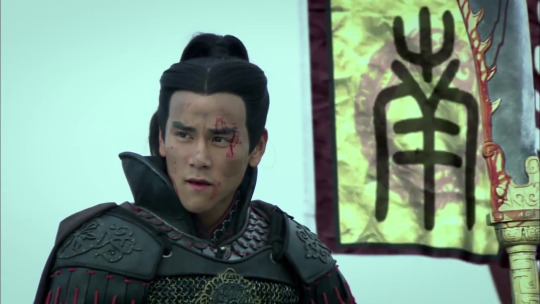
Ling Buyi, Love Like the Galaxy

Zhousheng Chen, One and Only

Zhao Yun, God of War Zhao Yun

Sima Yi, Secret of Three Kingdoms
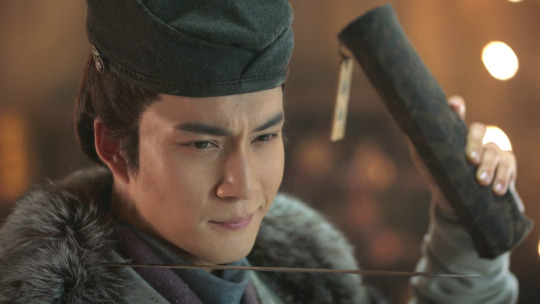
Han De Rang, The Legend of Xiao Chuo

Zhan Beiye, Legend of Fuyao
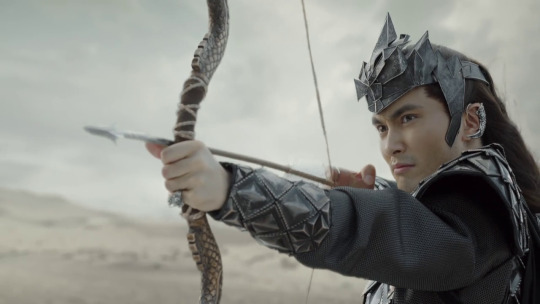
Gao Chang Gong, Lan Ling Wang

Xiang Yu, Story of Han Dynasty

Cao Pi, The Advisors’ Alliance

Meng Tiang Fang, Ancient Terracotta War Situation
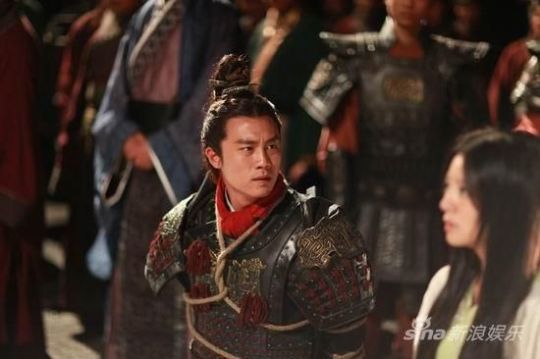
Chu Bei Jie, General and I
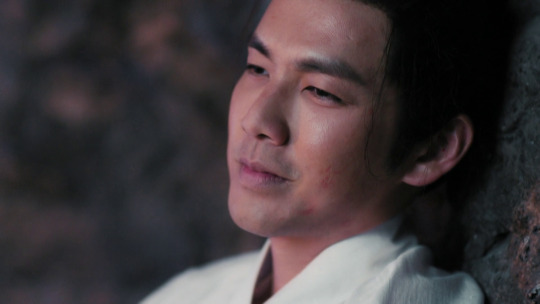
Zhu Zan, Jin Jiu Ling

Wolfie, The Wolf

Xiang Yu, Legend of Chu and Han

Cheng Yi, The Promise of Chang’an

Liu Xiu, Singing All Along

Huo Xin, Painted Skin the Resurrection
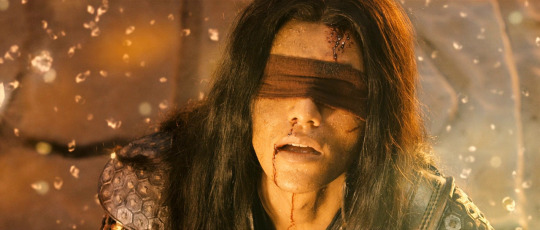
Meng Qi You, Glamorous Imperial Concubine

Yang Bros, The Young Warriors

Weng Gui, Princess Jieyou

Xiao Ping Zhang, Nirvana in Fire 2
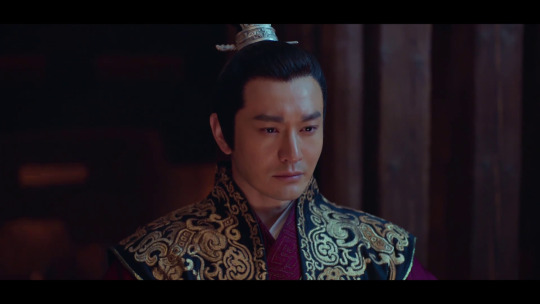
Pei Zhao, Maiden Holmes

Ji Ye, Novoland Eagle Flag
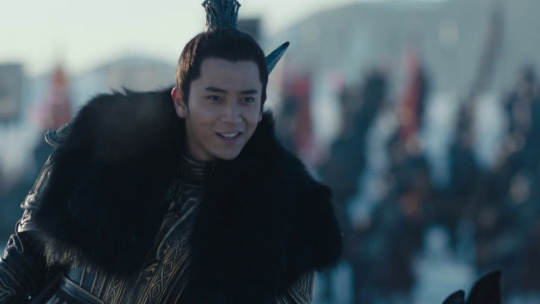
Zhu Qi Zhen, Imperial Doctress (it’s a reach he’s an emperor. But he leads his force in battle and I wanted Wallace Huo there so...)

Yuan Ling, Lost Love in Times

Yi Xiao Chuan, The Myth

Gu Tingye, The Story of Ming Lan
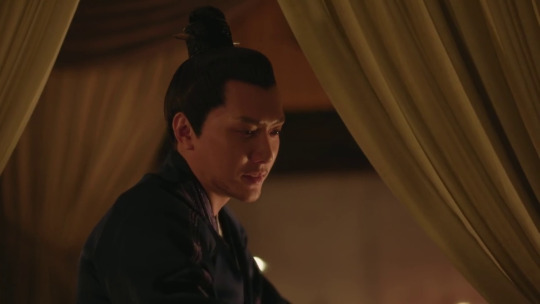
Lu Bu, Three Kingdoms 2010

Xu Lingyi, The Sword and the Brocade

Yue Fei, Patriot Yue Fei

Xiang Yu, The Myth

Ping Zhang, Nirvana in Fire 2

Guo Jing, Legend of Condor Heroes 2008

Xiang Yu, The Legend of Qin

#cdrama#the myth#the legend of qin#nirvana in fire 2#three kingdoms 2010#the story of ming lan#the sword and the brocade#singing all along#patriot yue fei#princess jieyou#general and i#legend of condor heroes#the story of han dynasty#the legend of xiao chuo#novoland eagle flag#ancient terracotta war situation#fight and love with a terracotta warrior#one and only#lan ling wang#legend of chu and han#the wolf#the promise of chang'an#god of war zhao yun#painted skin resurrection#lost love in times#the imperial doctress#glamorous imperial concubine#rebel princess#monarch industry#maiden holmes
140 notes
·
View notes
Text
Dubrovnik Uncovered - A Journey of Discovery Through History and Beauty
Dubrovnik has a wealth of history, from the 7th century through the Yugoslav Wars, there's a endless amount of interesting facts to learn about. The city has become one of the top destinations to go on GOT tours due to the Game of Thrones hype. There were many scenes filmed in this region.
The Rector's Palace is a museum of culture and historic museum that has a beautiful courtyard. From here, you may enjoy the city walls, and look out over the Large Onofrio Fountain.
St Blaise Church
The Church of St Blaise is situated in Luza Square, at the eastern end of Stradun - Dubrovnik's main thoroughfare. The church is dedicated to saint Blaise who was a Christian martyr and bishop. There aren't many details about the life of the saint but he was among of the most famous saints in the Middle Ages.
In Dubrovnik he is called Sveti Vlaho and the feast day for him is on the 3rd of February. He is considered the protector of Dubrovnik. his image is carved in stone, above all of the Dubrovnik gates, as well as on its official seals and coinage.
The church was built during the 14th century, in a Romanesque style However, it was reconstructed in 1715, in the extravagant Baroque style of local constructors following an earthquake that devastated the area. The interior has a massive silver and gold-plated statue of the patron saint who was made in one of Dubrovnik's famous workshops in the 15th century.
Cathedral of the Assumption of the Virgin Mary
While walking through the walls of Dubrovnik you will be transported back to the past. In this excursion your guide will highlight the essential role that these imposing structures played in protecting the city's residents and ensuring its prosperity. Discover why sites such as the Revelin Fortress, Minceta Tower, as well as Lovrijenac Fortress were so crucial in this endeavor.
Start your tour from Pile Gate. Explore the magnificent Franciscan Monastery, Orlando's Column and Rector's Palace. All while learning about the city's rich past from your guide. It's also possible to visit the Cathedral of the Assumption of the Virgin Mary The church is dedicated to the assumption of Mary into Heaven. It's a belief that was a source of controversy in early Christianity due to the fact that it disregarded the body of the saint and promoted ecclesial unity.
youtube
After that, you'll be able to see sweeping perspectives of Dubrovnik from the summit of the Minceta Tower. You'll also spot some famous shooting locations from the hit HBO series Game of Thrones.
City Walls
Take in breathtaking views and old treasures on this comprehensive tour through Dubrovnik's Old Town. Stroll the city walls with a guide and listen to captivating stories while passing landmarks like the Outer and Inner Ploce Gates.
Admire the spectacular views of the Adriatic Sea and the terracotta colored rooftops as you stroll around the 13th century walls. Your guide will explain their significance and importance in this UNESCO World Heritage listed city. Also, you can visit the lavish Rector's Palace, built in the 15th century to experience the life of the aristocratic class.
Discover why this city earned its UNESCO World Heritage listing on this guided walking tour. Explore 2,000-meters of pristine stones with your guide. Also, snap pictures of landmarks like Large Onofrio's Fountain, Orlando's Column and Lovrijenac Fortress. It's the best opportunity to explore the best of the city's sights and get a better knowledge of how this influential port grew into one of Europe's richest maritime republics.
Dubrovnik Museum
Dubrovnik Museum is a remarkable mixture of Gothic and Renaissance. Its restored Rector's Palace is the city's museum of culture and history. Visit the Rector's residence as well as the courtroom and ground-level dungeon to see what the city was like in earlier times. The museum also contains the collection of ancient artifacts which show the city's function as a merchant center and a rival to Venice in shipping and trade.
Visit the Natural History Museum in Dubrovnik to experience a different perspective from history. The exhibits here include a 100-year-old taxidermy specimen of Freddie Mercury and an algae herbarium. The museum also houses a assortment of local flora wildlife and other interesting objects.
https://www.youtube.com/watch?v=rCaUSNDUYH8
0 notes
Text
SAT / ACT Prep Online Guides and Tips
Quoted from "The Epic History of Garden Gnomes From Ancient Rome to Today"(Carrie Cabral Sep 6, 2019)
Garden gnomes. They might be your favorite decoration or your biggest pet peeve. Garden gnomes are small ornamental statues, typically resembling humans. Garden gnomes have been the subject of cultural fixation, reverence, and scorn, but have stayed an essential part of garden decor and more, even as debates raged about their purpose and pranksters tried to snuff them out. No matter what side of the garden gnome debate you’re on, learning the garden gnomes history is fun and enlightening.
What Are Garden Gnomes?
Traditional garden gnomes are male and bearded and have pointy hats. Some are depicted participating in leisure activities. Female garden gnomes are less common and usually don’t have beards. Today, garden gnomes can also portray popular figures or stereotypes. Biker gnomes, for example, have the traditional pointy hats and beards but also wear leather vests. There are a lot of ways to be creative with gnomes. They can be depicted doing different activities, and can have signs, plaques, or props to accompany them. Garden gnomes are modeled after gnomes, small, mythical creatures whose folklore arose during the Renaissance in Europe. Gnomes appeared prominently in Romanticist art and fairy tales as humanoid creatures that lived deep in the forest, primarily underground, and resisted contact with humans. In stories, gnomes sometimes protected and guided humans when they did come in contact with them, and sometimes had magical abilities. In some darker fairy tales of the period, gnomes led humans to their demise by tricking them.
The History of Garden Gnomes
How did these little guys wind up in gardens, you ask? Well, first we have to take a little step back to ancient Rome, where the history of the garden gnome begins. Garden statues have always been popular. Ancient Romans placed statues of the fertility god Priapus in their gardens, to help the plants grow and flourish. During the Renaissance and the Romantic period, people also placed status in their garden of figures like hunchbacks, which they called "grotesques." Art influenced these decisions, as people modeled their decor after the culture of the day. In the 18th century, people began adding small gnome-like figures made of wood or porcelaininside their homes. They referred to these figures as "gnomes," inspired by fairy tales. In Germany, the fairy tales further inspired the production of the statues, as people conflated the myths and folklore with the figurines.
Because the traditional gnome lived in a forest and was associated with the Earth, people began putting the gnomes in their gardens as well. The appearance of garden gnomes varied by region depending on that region's folklore, so the gnomes sometimes appeared jolly, or older and more human depending on the region. Around this time, garden gnomes took off in Europe and were primarily found in the gardens of the wealthy as a symbol of fashion and status.In 1847, Lord Charles Isham brought 21 terracotta garden gnomes to his home in Northamptonshire to be featured in the garden. Only one of the gnomes, nicknamed Lampy, survives to this day and is on display at the estate. Isham effectively brought gnomes to England and made them fashionable for the upper classes, a major turning point in garden gnome history. Sir Frank Crisp owned the second largest collection of garden gnomes in England, and opened his estate up once per week between the years of 1910 and 1919 to the public so people could view his garden and garden gnome collection. As gnome demand grew, manufacturers in Germany flourished. This meant that cheaper options for gnomes were available, and they were also displayed in the gardens of people from all socioeconomic classes.
Garden Gnomes in the 20th Century
The aftermath of World War I was particularly hard on Germany, whose garden gnome manufacturers were met with little demand for ceramic figurines and had very little resources. Garden gnome popularity greatly declined at this time, but the history of garden gnomes wasn't over yet. Some garden gnome manufacturers recovered in the 1930s after the release of Snow White and the Seven Dwarves. They found that there was newly renewed interest in garden gnomes, and the appearance of the garden gnomes was "Disneyfied" to reflect the cartoon-like innocence of the animated dwarves. However, the garden gnome industry declined again during and after World War II, as time and resources were devoted to the war effort. In the 1970s, gnome-makers began producing novelty gnomes, and modeled them after politicians, celebrities, or other popular figures. Gnomes were mass-produced, cheap and readily available. Since they were so cheap and since they were produced in jokey form, they lost a lot of the artistic and whimsical reputation they once had.In the 1990s, garden gnomes re-captured public attention when a group of pranksters in France, called the Garden Gnome Liberation Front, gained fame for stealing gnomes, taking them traveling, and sending pictures back to the owners, or simply taking the gnomes and leaving them in allegedly funny situations for people to find. Often, the garden gnomes are given signs claiming that they wanted freedom, or that they had other motives for "escaping."Some thieves returned the gnomes, and others collected large groups and then set them up in scenes in public spaces. The goal of the GLF was to "free" the gnomes, but many owners of these gnomes were incredibly upset that their gnomes disappeared. Some unofficial gnome liberation groups still operate, though the original group in France was caught and fined.
Gnomes in Pop Culture
Yard gnomes have appeared in popular culture regularly over the past few decades, though they don’t necessarily decorate gardens the way they once did. The World of David cartoon aired on Nick Jr. in the 1980s and featured a gnome named David who lived in the forest. The Goosebumps series featured a gnome as a villain in both the book and show, which is a possible pre-requisite to the zombie and horror gnomes that we still see today. Travelocity also used a gnome in their ad campaign starting in the early 2000s, as the gnome traveled the world. This was shortly after their height of the garden gnome liberation thefts, all of which personified the gnomes, showing them with voices and personalities, and going on adventures. This friendly attitude toward garden gnomes had always been there, but the more human the gnomes became, the more actual humans became attached to them. German artist Otto Horl displayed an art installation of 1,250 garden gnomes posing as Nazis in 2009. Though controversial, this did further the viewpoint of lawn gnomes being personified and having a purpose, names, etc. Halloween gnome costumes became popular as people dressed up as gnomes and crossed into other depictions and themes, like Gnome Chomsky, modeled after linguist and philosopher, Noam Chomsky. The Netflix series Trollhunters even includes a character named Gnome Chompsky. Making a costume out of a gnome version of something became popular, and helped repopularize novelty gnomes for a time. The animated movie Gnomeo and Juliet was a take on the classic Romeo and Juliet, and incorporated many Gnome-themes like forests and gardens into the lives of the gnome families.
The Great Garden Gnome Debate
Despite their early history as exclusive decorations for the wealthy and powerful, garden gnomes today rarely have the same status and are sometimes even viewed as “tacky.” The Chelsea Flower Show famously banned gnomes until 2013, and permitting them at the show was considered a highly controversial move since it "degraded" the gardens. However, those who complained about the lawn gnomes received significant backlash, and were accused of being snobbish, since garden gnomes are common in middle and working class homes. This debate has been going on for most of the history of garden gnomes, which is part of why gnomes gained and lost popularity repeatedly throughout the years. Also, due to their humanoid appearance, garden gnomes seem to be a target for humans to want to put them in funny situations, like in Travelocity’s ad campaign. Funny videos of gnomes doing human activities like “directing traffic” can sometimes go viral. Today, gnomes are known for being funny rather than dignified. There are still serious collectors of garden gnomes, but they aren't necessarily serious gardeners—hence the view of some gardeners that gnomes are a novelty, not a garden piece. Ultimately, it's up to an individual to decide if they want to include a garden gnome in their home. Some people today make elaborate “fairy gardens” and create a whimsical space in which to place their gnomes. Others add a gnome for a humorous touch. Garden gnomes, however, you feel about them, have long been a part of gardening culture. While gnomes may never have a totally secure place in gardens, they are clearly here to stay and hopefully looking forward to the next step in their colorful lives.
1 note
·
View note
Text
Vacationing the Silk Road

21st Century Maritime Silk Road
Wonderful Silk Road, as a deal route arose in W-century BC and lasted before sixteenth century. Many destructive wars, destruction, fires, starvation and pestilence have seen the actual ancient trading cities coupled Traveling the Silk Street. Some of them have sunk straight into oblivion, leaving the wrecks of the legendary descendants, aside from once blazed with flames, and killed again enhanced, to amaze the world using riches, blue domes, openwork terracotta band of mausoleums and mosques. Centuries multi-lingual, bazaars, hundreds of years along the grungy caravan roads were brought for sale to Europeans silks and precious stones, seasonings and dyes, gold and silver, unique birds and animals southern region.
21st Century Maritime Silk Road
Traveling the Silk Highway, one of the most significant achievements from the history of world world. Widespread network of caravan ways crossed Europe along with Asia from the Mediterranean for you to China and served throughout ancient times an important means of business and cultural exchanges involving East and West. Typically the longest part of the Silk Path passed through the territory involving Central Asia, including Kyrgyzstan. Caravans laden with a silk filled duvet from China, spices and important stones from India, gold goods from Iran, Délicat paintings, afrosiab ceramics and many more goods went through the deserts of Karakum and Kyzyl Kum, through the oases connected with Merv and Khorezm, the particular boundless steppes of Sary-Arka; overcame passes of the Pamirs, Tien Shan, Altai, surpassesd the river Murghab, Amu Darya and Syr Darya.
On the road caravans began to come through and flourish the prosperous cities, trade and art settlements, caravan sheds. Turkmenistan - Merv; Uzbekistan -- Bukhara, Samarkand, Urgench, Khiva. Kazakhstan - Otrar, Turkestan, Taraz, Ispedzhab. Kyrgyzstan : Julie, Suyab, Novokent, Balasagun, Borskoon, Tash-Rabat, Osh, Uzgen.
European countries to collaborate in addition to communicate with countries of Asian countries. Ecumene Hellenic closed rates high with ecumene East. Along with like the two communicating boats so different civilization did start to pour into one another their very own knowledge. Arteries connecting typically the vessels were trade tracks. For him not only trafficked goods, for centuries the road to get agents of culture, scientific research, technology and religion. Key Asia, situated between Tiongkok and India in the far east, between Persia and Persia to the south, the European entire world in the west, the Volga as well as Siberia in the north, close to two thousand years ranking at the crossroads of industry routes.
One of the first who defined this trade route, historians believe the Chinese diplomat Zhang Tsanya, who occupied the I century BC. The fact that in this period, Middle Asia became embroiled with trade relations with The far east, demonstrate a large number of Chinese money, bronze mirrors, silk textiles, remnants, fragments of porcelain tableware made in China, identified during archaeological excavations. Consuming China in Central Parts of asia began to develop sericulture and report doing, and from Main Asia, China took up growing of grapes, alfalfa, onions, cotton, pomegranate, walnut, fig trees and cucumbers.
Simple servant of the Firm Florencia Bardi Francesca Pagolotti went back in 1355 after 8-10 years of absence back home within Italy, for his neck were thousands of Chinese, Arabic and European farsahs mls of the Great Silk Route. He became the author of any tome "The practice associated with trade, or a treatise about land division, trade procedures, and other things, information and that is necessary for merchants of all international locations. "
The paradox is its current name, this kind of ancient road was merely in the nineteenth century, consist of by Ferdinand von Riztgofena, author of classic effects the physical geography regarding China and the orography involving Asia, with a light side that this name is acknowledged everywhere. Warmly welcomed by simply world public opinion the choice of UNESCO on the intercontinental program "The Great A silk filled duvet Road, the path of normal gardening to organic, mutual understanding and rapprochement of cultures. The Great Man made fiber Road, like the Phoenix pet bird, begins its rebirth.
Let's take a go to the road! And you will view magnificent architecture, get acquainted with often the picturesque nature, feel some sort of hot desert wind, start to see the dazzling mountains, marvel with the beauty of soaring birds. Try looking in the past and in it you will observe today. Have a nice trip to the truly great epoch and the legendary Cotton Road.
1 note
·
View note
Photo



THE RAPE OF EUROPA: Hannibal AU Season 1 by Kathrynethegreat
SUMMARY
When Clarice Starling, freshly graduated from Quantico has her ambitions of joining Jack Crawford in the Behavioral Science Division of the F.B.I. dashed by a vengeful Paul Krendler and is instead assigned to investigate a case in Boston that’s going nowhere, she proves her worth by helping to create a new division for the Bureau – The F.B.I. Art Crime Team – which specializes in recovering stolen art and antiquities. Clarice’s investigations take her overseas, where she soon finds herself embroiled in the midst of a crime ring run by Japanese art collector, business tycoon and suspected Yakuza, Hiroshi Soah. Further complications arise when Agent Starling’s dealings bring her into direct contact with the recently escaped serial killer Hannibal Lecter, who is searching for pieces of his stolen past. Having worked together before to catch Buffalo Bill, and unable to capture the doctor without ruining her mission, Clarice and Lecter must once again forge a precarious temporary alliance, forcing Clarice to face the complex questions that surround the returning of art to its rightful owners – questions that are closely bound together with hundreds of years’ worth of colonialism, war, occupation, and plunder.
LOCATIONS
Japan, China, Egypt, India, U.S.A.
EPISODES
Season 1, Episode 1: The One-Eyed Dragon of Ōshu
When a priceless Vermeer is stolen from the Isabella Stuart Gardner Museum, Clarice Starling is assigned to the F.B.I. task-force in charge of working to recover it. A dinner with Noble Pilcher’s family takes an unexpected turn. The estate sale of the late Lady Murasaki in Hiroshima, Japan garners the interest of the art community and sends up a red flag for the F.B.I.
Season 1, Episode 2: A.A.Aaron
An unexpected note in The China Mail leads Clarice on the chase for one of Gardner pieces. Clarice ruffles Paul Krendler's feathers by trying to make the best of a bad situation. Miranda Pilcher, head curator of the National Gallery, helps Clarice assemble and train her new team. Hannibal Lecter encounters an old friend who has some interesting information to share.
Season 1, Episode 3: Eternity in Eight Strokes
Hiroshi Soah requests that Dr.Fell teach his daughters, Natsu, Aneka, and Emiko in the arts in addition to his work as curator. Clarice learns that the world of stolen antiquities can often be a facade for far darker crimes. Jack Crawford pulls some strings to have an old friend from Quantico assigned to Clarice's team for her protection.
Season 1, Episode 4: The Provenance of Dr.Fell
When Clarice and Johnny go undercover at a ball honoring Hiroshi Soah's newest art acquisition, Clarice comes face to face with Dr.Fell, but cannot reveal his identity without ruining her own mission.
Season 1, Episode 5: Sadako and the Thousand Cranes
Chiyoh and Lecter discuss old times and come to an agreement. Johnny's new surroundings bring back painful memories. Clarice finds herself one step closer to finding the ancient Chinese Gu stolen from the Gardner Museum, but her continual calls and memos to Behavioral Science regarding Hannibal Lecter continue to be intercepted by Paul Krendler, who has his own plans for the doctor.
Season 1, Episode 6: Kyū Bon
An ancient manuscript goes missing during a three-day festival honoring the dead. Hiroshi's eldest daughter, Natsu is intrigued by the mysterious and charming Dr.Fell. A string of flowers brings a surprise. Clarice visits her father's grave.
Season 1, Episode 7: Honjō Masamune
Clarice is desperate to join Behavioral Science when a Florida serial killer captures the attention of the media. Completely unaware of either of their true identities, Hiroshi Soah hires Clarice’s undercover identity, Elizabeth Chase to work alongside Dr.Fell in tracking down and recovering a famous sword taken from an ancient Japanese family after WWII. When a familiar dream resurfaces, Clarice finds comfort in an unexpected place. Dr.Fell teaches Elizabeth Chase the art of Japanese sword fighting.
Season 1, Episode 8: The Hall of Two Truths
When eighteen carefully chosen treasures are stolen from the Cairo Museum, the Minister of Antiquities enlists Clarice's team to help find the culprit. Clarice suspects that a wealthy private collector may be responsible, but soon finds that the truth is far more complicated than she could have imagined.
Season 1, Episode 9: Kintsugi
Clarice discovers that a series of forgeries of Terracotta Warriors of Emperor Qin Shi Huang might not be what they seem. When Emiko Soah breaks a priceless vase in her father's collection, Dr.Fell uses it as a teaching experience, but shadows from his past threaten his calm.
Season 1, Episode 10: The Three Sacred Treasures of Japan
When an ancient and highly guarded set of treasures never seen by the public eye are stolen, Clarice and her team must work to restore them to the Emperor of Japan. Matters are further complicated when it is discovered that the treasures are so sacred, that no photos are known to exist. The F.B.I. Art Crime Team must attempt to find the objects without knowing just what it is they are even looking for.
Season 1, Episode 11: The Last Emperor
When news re-surfaces of Emperor Puyi's puzzle box, said to contain a great treasure, Clarice travels to China to find if there is any truth to the claims. A miscalculation accidentally leads Clarice to a different missing artifact. Natsu makes an upsetting discovery in Dr.Fell's studio.
Season 1, Episode 12: The Idol Thief
When several statues believed to have been stolen from temples in India make their way into the hands of museums across the globe, Clarice and her team must follow the provenance of each piece in the hopes of being led back to the original culprit. When much of the paperwork turns out to have been faked, Clarice finds she must now hunt two criminals - a corrupt art dealer, and a world-class document forger. While trying to uncover more information about Dr.Fell’s past, Natsu is surprised to find Elizabeth Chase is also hiding secrets.
Season 1, Episode 13: Yuanming Yuan
When several museums around the world are simultaneously robbed of their Chinese antiquities, Clarice’s team works to link the stolen pieces together in an effort to find the mastermind behind the heist.
Season 1, Episode 14: Teacups and Time
Clarice Starling chooses to keep the discovery of the Chinese Gu a media secret in order to continue using Elizabeth Chase as her false identity, but when Elizabeth is invited to a Japanese Tea Ceremony with Hiroshi Soah, Dr.Fell, and Chiyoh, Clarice wonders if her identity may have already been compromised.
Season 1, Episode 15: The Tantō Sword of Date Masamune
Elizabeth Chase watches Dr.Fell teach Hiroshi’s three daughters a lesson in Japanese weaponry. A jealous Natsu seeks revenge but gets more than she bargained for. When a raid on Hiroshi Soah's private collection goes wrong, Clarice Starling and Hannibal Lecter must make difficult choices.
OVERVIEW
SEASON 1 SUMMARY | SEASON 1 DETAILS
SEASON 2 SUMMARY | SEASON 2 DETAILS
SEASON 3 SUMMARY | SEASON 3 DETAILS
SEASON 4 SUMMARY | SEASON 4 DETAILS
#hannibal#clannibal#hannibal lecter#hannibal au#clarice starling#silence of the lambs#the silence of the lambs#the rape of europa#fan fiction#fan fic#my edits
39 notes
·
View notes
Text
Copenhagen Architecture News: Buildings
Copenhagen Architecture News 2021, New Buildings in Denmark, Danish Construction Designs, Property Images
Copenhagen Architecture News
Contemporary Buildings in Denmark: New Danish Built Environment Updates
post updated 21 September 2021
Copenhagen Architectural News
Copenhagen Architectural Design News, chronological:
Copenhagen Architecture Designs – chronological list
Copenhagen Architecture Tours : city walks, experienced architect guides by e-architect
21 September 2021
World Capital of Architecture News
Copenhagen has been named UNESCO World Capital of Architecture for 2023.
Following Rio de Janeiro’s inaugural title role, the Danish capital city has been named World Capital of Architecture for 2023 by UNESCO. It will host the International Union of Architect’s World Congress 2 years from now.
1 September 2021
Isfuglen Winter Bathing House , Brøndby Marine Harbor
Design: Matters architects
photos : Helene Høyer, Brian Berg
Isfuglen Winter Bathing House Copenhagen
The winter bathing club “Isfuglen” is a club for winter bathers and houses a community room, changing facilities and sauna. It is located at the very tip of the entry point to Brøndby Marine Harbor. The location is unique and gives the house and its members a special opportunity to become an authentic part of the active harbor life.
13 Aug 2021
Ordrupgaard Museum
Architects: Snøhetta
photo : Laura Stamer
Ordrupgaard Museum, Copenhagen Denmark
Situated near Jægersborg Dyrehave, north of Copenhagen, Ordrupgaard houses Northern Europe’s most comprehensive collection of French and Danish art from the 19th and early 20th century. Originally built as a three-winged country mansion in the neo-classical style during World War I, the museum was expanded by a modern 1,150 sqm glass and black lava concrete extension in 2005, designed by Zaha Hadid.
13 Jun 2021
CHART Architecture competition
image courtesy of designers
CHART 2021 Architecture Competition
Relax under a freshly grown field of microgreens, listen to sounds from suspended ventilation ducts, and create your own space with industrial dunnage bags. The finalists for this year’s CHART Architecture competition have been selected for the new and creative ways they investigate creating social and sensory experiences.
9 May 2021
Bispeberg Laboratory and Logistics, Bispebjerg
Design: Mikkelsen Architects
photograph : Hampus Berndtson
Bispeberg Laboratory and Logistics
Bispebjerg Hospital in Copenhagen is a heritage-listed complex designed by Danish architect Martin Nyrop. The hospital is currently the focus of a master plan by BDP, and in anticipation of this, its logistics have been orchestrated by a new intervention on the campus — ‘Lab Log’.
5 May 2021
Lynetteholm København – New Copenhagen harbour island
Design: COWI, Arkitema and TREDJE NATUR
image courtesy of architects practice
Lynetteholm, New Copenhagen harbour island
The new island will be established east of the city and in 2070 have a size of 275 acres. In Copenhagen, the Danish government and the City of Copenhagen have agreed to establish a new island that will eventually develop into a new, attractive district with room for more than 35.000 inhabitants as well as new infrastructure.
1 Mar 2021
IZUMI Frederiksberg
Design: PAN- PROJECTS
photograph : Yuta Sawamura
IZUMI Frederiksberg
IZUMI Frederiksberg is a second interior design project for a restaurant IZUMI locates in Copenhagen. IZUMI is a chain restaurant serves “Nordic twisted” Japanese cuisines that holds several restaurants around greater Copenhagen.
Updated 4 Feb 2021
Carlsberg Central Office, Valby
Design: C.F. Møller Architects
photograph : Adam Mørk
Carlsberg Central Office Valby
The new Carlsberg Central Office sets the framework for a modern and dy-namic workplace, with a building that supports identity, knowledge sharing, and inno-vation. This is emphasized with a large open atrium that binds the entire company together in one unified working community, integrated with the connecting the past with the future.
21 Jan 2021
Symbiosis Houses, Herlev
14 Jan 2021
Tea house Ø
2 Dec 2020
Vridsløselille Masterplan
3 Sep 2020
AIRE Ancient Baths, Hotel Ottilia, Ny Carlsberg Vej 101, 1799 Copenhagen
Design: Arkitema
image from architecture office
AIRE Ancient Baths
Thermal baths, massages, and a unique atmosphere where time does not exist. AIRE Ancient Baths, the luxurious wellness concept, opens the doors to a new Copenhagen branch in the same historic building as Hotel Ottilia.
17 June 2020
Arup and Cobe’s new metro stations celebrate Copenhagen’s redeveloped docklands
Design: Arup and Cobe
photo : Rasmus Hjortshøj – COAST
Nordhavn Station + Orientkaj Station Copenhagen
Part of the Nordhavn metro line extension connecting the docklands to Copenhagen’s city center, Arup and Cobe have worked together to design two new metro stations, Orientkaj and Nordhavn, under the Nordhavn metro line extension. The recently opened public transport link unlocks the potential for the redevelopment of Copenhagen’s northern docklands, one of the largest urban regeneration projects in northern Europe.
9 June 2020
Sdr. Asmindrup Church in Vipperød
9 June 2020
Karen Blixens Plads
Copenhagen School Building Designs
Copenhagen School Buildings – new post collecting education architecture in the Danish capital city.
27 Mar 2020
UnSchool Copenhagen Architecture Competition Winners
1st Prize: Miriam Fenner, Oliver Fenner, UK
image courtesy of designers
UnSchool Copenhagen Architecture Competition
4 Nov 2019
Panda House, Copenhagen Zoo, Roskildevej 32
Architects: BIG
photo : Rasmus Hjortshøj
Panda House, Copenhagen Zoo
The new home for giant pandas Mao Sun and Xing Er in Copenhagen Zoo resembles the panda’s natural habitat and creates a peaceful living environment for one of the world’s rarest mammals.
26 July 2019
BIG presents FORMGIVING, DAC, BLOX
photos © Harriet Lomholt-Welch
Danish Architecture Center Exhibition by BIG until January 5, 2020
DAC Exhibition
3 Jun 2019
CHART 2019 Architecture Winners
images courtesy of designers
CHART 2019 Architecture Competition Winners
Building Updates for Danish Capital City
4 Dec 2018
Carlsberg Central Office, Valby
Design: C.F. Møller Architects
image Courtesy architecture office
Carlsberg Central Office in Valby
The Carlsberg Group’s new central office provides the framework for a modern and dynamic workplace, where the intention has been to design a building that creates identity, knowledge sharing and innovation. At the same time it has been important that the building stands in harmony with its surroundings and has the aesthetic quality that characterises Carlsberg as a company.
27 Nov 2018
UN17 Village Ørestad
26 Nov 2018
Amager Resource Centre
31 Oct 2018
Tingbjerg Library and Culture House, Tingbjerg, Skolesiden 4, DK-2700 Brønshøj, Denmark
Design: COBE
photo : Rasmus Hjortshøj – COAST
Tingbjerg Library and Culture House
Danish architects COBE reinterpret Danish modernism in this building, creating a new social and cultural destination in the Copenhagen neighbourhood Tingbjerg that invites community interaction, engagement and signals a new urban transformation.
9 Oct 2018
Dortheavej Apartments, Copenhagen, Denmark
Design: BIG – Bjarke Ingels Group
photo : Rasmus Hjortshoj
Dortheavej Apartments in Copenhagen
BIG fulfills “Homes for All” mission for non-profit affordable housing association Lejerbo with the recently completed 6,800m2 winding wall in Copenhagen’s multicultural northwest area. The building offers 66 new homes to low-income citizens featuring unprecedented 3.5m ceilings, generous floor to ceiling windows and outdoor terraces, realized on a strict budget.
30 Jun 2018
New office building for Nordea Bank – Shortlisted at World Architecture Festival 2018 Awards
Design: Henning Larsen Architects + Signal Architects + SLA Landscape Architects
image © Henning Larsen Architects
Nordea Bank Ørestad North Office on World Architecture Festival Awards 2018 Shortlist
Henning Larsen Architects and a team consisting of Signal Architects and SLA Landscape Architects have won the competition for Nordea Bank’s new office building of 40,000 m2 in Ørestad North, Copenhagen, next to the premises of the Danish Broadcasting Corporation and the Concert Hall – Koncerthuset. The building will comprise Scandinavia’s largest trading floor of 5,500 m2 with a view of the green area of Amager Fælled.
15 Jun 2018
Tivoli Hjørnet – winner at American Architecture Awards 2018
Design: Pei Cobb Freed & Partners Architects
photography : Pei Cobb Freed & Partners
Tivoli Hjørnet wins at American Architecture Awards 2018
An undulating glass and terraced terracotta pavilion opened at Tivoli Gardens on November 17 to public acclaim. The new building transforms the western edge of the historic park and brings fresh excitement to Copenhangen’s urban core.
7 May 2018
BLOX – Danish Architecture Center, Bryghuspladsen
Design: OMA
photo © Clement Guillaume
BLOX – Danish Architecture Center
The BLOX project, home of the Danish Architecture Center (DAC), contains exhibition spaces, offices and co-working spaces, a café, a bookstore, a fitness centre, a restaurant, twenty-two apartments and an underground automated public carpark, but it is not the acrobatic mixing of uses that defines this project; its ultimate achievement is in ‘discovering’ its own site.
6 May 2018
Experimentarium Science Center Extension
Design: CEBRA Architects
image courtesy of Pressential
Experimentarium Science Center
This world class science centre provides families, school children and science lovers high-quality science exhibitions where they can touch and play and experience science in an innovative new way.
20 Mar 2018
The Maersk Tower, Nørre Campus, Blegdamsvej
Design: C.F. Møller Architects
photo : Adam Mørk
The Maersk Tower
C.F. Møller Architects receive the MIPIM 2018 Award for ‘Best Healthcare Development’ for this new building.
The Maersk Tower is a state-of-the-art research building whose innovative architecture creates the optimum framework for world-class health research and stands out as a landmark in Copenhagen, while also contributing to developing the local area.
16 Jan 2018
New Aquatics Centre
Architects: Kengo Kuma & Associates and Cornelius Vöge
image Courtesy architecture office
New Aquatics Centre on Copenhagen Waterfront
A waterfront cultural centre with harbour baths, which will offer iconic architecture, facilities for leisure and sports associations and unique water experiences: now, a unanimous jury have selected Japanese architect firm Kengo Kuma & Associates, in team with Danish architect firm Cornelius Vöge, Søren Jensen engineers and architect Niels Sigsgaard, as the winner of the architect competition for Paper Island’s future waterfront cultural centre.
8 Jan 2018
New Islands Brygge School, København S
Design: C. F. Møller Architects
image courtesy of architects office
New Islands Brygge School Building in Copenhagen
The New Islands Brygge School is taking shape between Islands Brygge’s vibrant city life and Amager Commons’ green countryside – a new school building for lower-secondary pupils, and with special focus on food and movement.
Copenhagen Architectural News
Copenhagen Architectural Photos
More Copenhagen Architectural News online soon
Location: Copenhagen, Denmark, northern Europe
Architecture in Copenhagen
Copenhagen Architecture Tours
Copenhagen Architecture News 2009 – archive
Copenhagen Architect – design office listings
Copenhagen Architecture
Copenhagen Buildings : buildings listed alphabetically
Comments / photos for the Copenhagen Architecture News page welcome
Website: Copenhagen Denmark
The post Copenhagen Architecture News: Buildings appeared first on e-architect.
0 notes
Text
The Epic History of Garden Gnomes From Ancient Rome to Today

Garden gnomes. They might be your favorite decoration or your biggest pet peeve. Garden gnomes are small ornamental statues, typically resembling humans. Garden gnomes have been the subject of cultural fixation, reverence, and scorn, but have stayed an essential part of garden decor and more, even as debates raged about their purpose and pranksters tried to snuff them out. No matter what side of the garden gnome debate you’re on, learning the garden gnomes history is fun and enlightening.
You're reading: The Epic History of Garden Gnomes From Ancient Rome to Today
What Are Garden Gnomes?
Traditional garden gnomes are male and bearded and have pointy hats. Some are depicted participating in leisure activities. Female garden gnomes are less common and usually don’t have beards.
Today, garden gnomes can also portray popular figures or stereotypes. Biker gnomes, for example, have the traditional pointy hats and bears but also wear leather vests. There are a lot of ways to be creative with gnomes. They can be depicted doing different activities, and can have signs, plaques, or props to accompany them.
Garden gnomes are modeled after gnomes, small, mythical creatures whose folklore arose during the Renaissance in Europe. Gnomes appeared prominently in Romanticist art and fairy tales as humanoid creatures that lived deep in the forest, primarily underground, and resisted contact with humans. In stories, gnomes sometimes protected and guided humans when they did come in contact with them, and sometimes had magical abilities. In some darker fairy tales of the period, gnomes led humans to their demise by tricking them.
The History of Garden Gnomes
How did these little guys wind up in gardens, you ask? Well, first we have to take a little step back to ancient Rome, where the history of the garden gnome begins.
Garden statues have always been popular. Ancient Romans placed statues of the fertility god Priapus in their gardens, to help the plants grow and flourish. During the Renaissance and the Romantic period, people also placed status in their garden of figures like hunchbacks, which they called “grotesques.” Art influenced these decisions, as people modeled their decor after the culture of the day.
In the 18th century, people began adding small gnome-like figures made of wood or porcelain inside their homes. They referred to these figures as “gnomes,” inspired by fairy tales. In Germany, the fairy tales further inspired the production of the statues, as people conflated the myths and folklore with the figurines.

Read more: 28 Absolutely dreamy Bohemian garden design ideas
Because the traditional gnome lived in a forest and was associated with the Earth, people began putting the gnomes in their gardens as well. The appearance of garden gnomes varied by region depending on that region’s folklore, so the gnomes sometimes appeared jolly, or older and more human depending on the region. Around this time, garden gnomes took off in Europe and were primarily found in the gardens of the wealthy as a symbol of fashion and status.
In 1847, Lord Charles Isham brought 21 terracotta garden gnomes to his home in Northamptonshire to be featured in the garden. Only one of the gnomes, nicknamed Lampy, survives to this day and is on display at the estate. Isham effectively brought gnomes to England and made them fashionable for the upper classes, a major turning point in garden gnome history.
Sir Frank Crisp owned the second largest collection of garden gnomes in England, and opened his estate up once per week between the years of 1910 and 1919 to the public so people could view his garden and garden gnome collection. As gnome demand grew, manufacturers in Germany flourished. This meant that cheaper options for gnomes were available, and they were also displayed in the gardens of people from all socioeconomic classes.
Garden Gnomes in the 20th Century
The aftermath of World War I was particularly hard on Germany, whose garden gnome manufacturers were met with little demand for ceramic figurines and had very little resources. Garden gnome popularity greatly declined at this time, but the history of garden gnomes wasn’t over yet.
Some garden gnome manufacturers recovered in the 1930s after the release of Snow White and the Seven Dwarves. They found that there was newly renewed interest in garden gnomes, and the appearance of the garden gnomes was “Disneyfied” to reflect the cartoon-like innocence of the animated dwarves. However, the garden gnome industry declined again during and after World War II, as time and resources were devoted to the war effort.
In the 1970s, gnome-makers began producing novelty gnomes, and modeled them after politicians, celebrities, or other popular figures. Gnomes were mass-produced, cheap and readily available. Since they were so cheap and since they were produced in jokey form, they lost a lot of the artistic and whimsical reputation they once had.
In the 1990s, garden gnomes re-captured public attention when a group of pranksters in France, called the Garden Gnome Liberation Front, gained fame for stealing gnomes, taking them traveling, and sending pictures back to the owners, or simply taking the gnomes and leaving them in allegedly funny situations for people to find. Often, the garden gnomes are given signs claiming that they wanted freedom, or that they had other motives for “escaping.”
Some thieves returned the gnomes, and others collected large groups and then set them up in scenes in public spaces. The goal of the GLF was to “free” the gnomes, but many owners of these gnomes were incredibly upset that their gnomes disappeared. Some unofficial gnome liberation groups still operate, though the original group in France was caught and fined.

Gnomes in Pop Culture
Yard gnomes have appeared in popular culture regularly over the past few decades, though they don’t necessarily decorate gardens the way they once did.
The World of David cartoon aired on Nick Jr. in the 1980s and featured a gnome named David who lived in the forest. The Goosebumps series featured a gnome as a villain in both the book and show, which is a possible pre-requisite to the zombie and horror gnomes that we still see today.
Travelocity also used a gnome in their ad campaign starting in the early 2000s, as the gnome traveled the world. This was shortly after their height of the garden gnome liberation thefts, all of which personified the gnomes, showing them with voices and personalities, and going on adventures. This friendly attitude toward garden gnomes had always been there, but the more human the gnomes became, the more actual humans became attached to them.
German artist Otto Horl displayed an art installation of 1,250 garden gnomes posing in Nazi salutes in 2009. Though controversial, this did further the viewpoint of lawn gnomes being personified and having a purpose, names, etc.
Halloween gnome costumes became popular as people dressed up as gnomes and crossed into other depictions and themes, like Gnome Chomsky, modeled after linguist and philosopher, Noam Chomsky. The Netflix series Trollhunters even includes a character named Gnome Chompsky.
Read more: 8 Natural & Homemade Insecticides: Save Your Garden Without Killing the Earth
Making a costume out of a gnome version of something became popular, and helped repopularize novelty gnomes for a time. The animated movie Gnomeo and Juliet was a take on the classic Romeo and Juliet, and incorporated many Gnome-themes like forests and gardens into the lives of the gnome families.
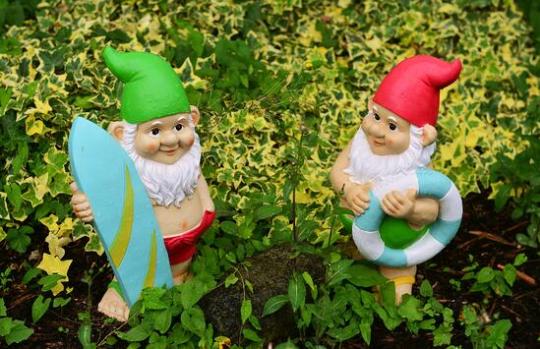
The Great Garden Gnome Debate
Despite their early history as exclusive decorations for the wealthy and powerful, garden gnomes today rarely have the same status and are sometimes even viewed as “tacky.” The Chelsea Flower Show famously banned gnomes until 2013, and permitting them at the show was considered a highly controversial move since it “degraded” the gardens. However, those who complained about the lawn gnomes received significant backlash, and were accused of being snobbish, since garden gnomes are common in middle and working class homes.
This debate has been going on for most of the history of garden gnomes, which is part of why gnomes gained and lost popularity repeatedly throughout the years. Also, due to their humanoid appearance, garden gnomes seem to be a target for humans to want to put them in funny situations, like in Travelocity’s ad campaign. Funny videos of gnomes doing human activities like “directing traffic” can sometimes go viral.
Today, gnomes are known for being funny rather than dignified. There are still serious collectors of garden gnomes, but they aren’t necessarily serious gardeners—hence the view of some gardeners that gnomes are a novelty, not a garden piece. Ultimately, it’s up to an individual to decide if they want to include a garden gnome in their home. Some people today make elaborate “fairy gardens” and create a whimsical space in which to place their gnomes. Others add a gnome for a humorous touch.
Garden gnomes, however, you feel about them, have long been a part of gardening culture. While gnomes may never have a totally secure place in gardens, they are clearly here to stay and hopefully looking forward to the next step in their colorful lives.
What’s Next?
Looking for more fun history? Check out these true stories about David Ghantt and Aleister Crowley, and this post on 1920’s Fashion.
If you are looking for exciting, unique ideas for your next research paper, check out our list of 113 Great Research Paper Topics, and 113 Persuasive Essay Topics. You can read our narrative essay and argumentative essay examples! Have friends who also need help with test prep? Share this article!
About the Author
Carrie holds a Bachelors in Writing, Literature, and Publishing from Emerson College, and is currently pursuing an MFA. She worked in book publishing for several years, and believes that books can open up new worlds. She loves reading, the outdoors, and learning about new things.
Source: https://livingcorner.com.au
Category: Garden
source https://livingcorner.com.au/the-epic-history-of-garden-gnomes-from-ancient-rome-to-today/
1 note
·
View note
Text
Why To Go Kathmandu?
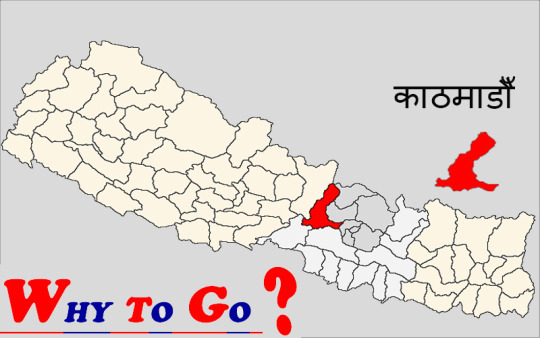
Kathmandu is the capital of Nepal and therefore the largest metropolitan city, the other 2 sister cities are Patan or Lalitpur and Bhaktapur. The short form of capital of Nepal is KTM, in terms of area Kathmandu valley is simply slightly smaller than Singapore. The capital of Nepal is enclosed by four major mountains, namely: Shivapuri, Phulchowki, Nagarjun and Chandragiri, the town stands at an elevation of roughly, 1,400 meters within the concave valley in central Nepal. The entire population of the capital of Nepal is 949,486 people. Kathmandu isn’t only the capital of the Federal Democratic Republic of Nepal however also the headquarters of the Central Region among the 5 development regions recognized by the 14 administrative zones of Nepal situated at the central a part of the country.
The central region has 3 zones, Bagmati, Narayani, and Janakpur. the capital of Nepal falls within the Bagmati Zone. Kathmandu, as the entrance to Nepal tourism, is the nerve of the country’s economy. With the foremost advanced infrastructure among urban areas in Nepal, Kathmandu’s economy is tourism-centric accounting for 3.8% of the GDP. the town of Kathmandu was named after a structure in Durbar Sq. known as Kasthamandap, that could be a Sanskrit word, Kastha is “wood” and Mandap is “covered shelter.” In 1596, King Laxmi Narsingh Malla designed this distinctive temple, which is additionally known as Maru Sthal. the complete structure contains no iron nails or supports and is created entirely from wood. Legend has it that the timber used for this two-story temple was obtained from one tree. Kantipur is the alternative name for the capital of Nepal, “Kanti” is an alternate name of the divinity Laxmi, and “our” means that the place where such a deity resides. Thus, the name Kantipur demonstrates the traditional belief that it’s the place wherever the Laxmi dwells.
Places To Visit in Kathmandu
Durbar Square Kathmandu: The place includes repository and different parts of the palace here are opened for guests. The place is home to Kumari Chok as well- it’s one amongst the foremost curious attractions of Nepal. Here, a gilded cage contains Kumari, a lady who was chosen to be the human reincarnation of a Hindu goddess, Durga.this mere truth alone this place among places to visit close to Kathmandu.
Swayambhunath Stupa: Located on high of a hill in the capital of Nepal depression, this tourist place in the capital of Nepal is an ancient fine arts marvel is one amongst the most effective attractions of the town. the whole complex is enclosed by a large kind of trees. It includes the main stupa, several shrines, temples, monastery, repository, and a well-stocked library. The temples are painted with the eyes and eyebrows of Gautama with the number 1 in native script painted as the nose of the lord, which could be a sight to lay eyes on in itself.
Indra Chowk: Makhan Tole’s busy street spills and brings you nearer to Indra Chowk, which could be a fashionable curtilage within the region. The place named once an ancient Vedic divinity, Indra is known for its market and cultural escapades. it’s here that you simply can realize merchants of blankets and garments, not far away stone Shiva Temple and beautiful façade of the Akash Bhairab Temple. excluding the market, one in every of the most important highlights of this place is the Sky Temple. This specific temple has four metal lions that seem to be rearing over the road. It conjointly includes 2 additional brass lions at the doorway, wherever non-Hindus can’t enter.
Narayanhiti Palace: Full of meeting rooms and Nineteen Seventies glamour, the palace has deluxe interiors. The place is standard for its repository beauty. Once, King Gyanendra lived in it, however, he was given fifteen days to vacate the property once his fall from the throne. This palace is additionally the place wherever aristocrat Dipendra massacred his family in 2001. The place is morbidly market and therefore the bullet holes are still visible on a number of the walls. however withal, this place offers a peek into the royal way of the royals, the one that folks only dream concerning.
Boudhanath (Stupa): A UNESCO World Heritage site and one amongst the biggest stupas within the world, the Boudhanath Stupa in the capital of Nepal could be an important place in Buddhism and architecture, both. situated on an ancient trade route that entered the capital of Nepal from Tibet. The place has seen several traders and travelers providing prayers to their lord here because the Stupa is considered to be the grave of the remains of Kassapa Buddha. With plenty of legends attached to the place, it’s one amongst the most effective places to visit in Nepal and simply deserves to be known as so.
Shivapuri Nagarjun National Park: The park was established in 2002 and it’s a known tourist place close to the capital of Nepal. variety of herbs prosper within the place, whereas the park has broad-leafed forests. The place comes alive with animals like Jungle Cats and Indian Leopard, Yellow-necked Marter, Himalayan Black Bear, Hanuman catarrhine, clouded leopard, wildcat, cervid and wild boar among different animals. Ornithologists have recorded over 318 species of birds at the place, together with barred cuckoo dove, Eurasian eagle owl, and golden-throated piciform bird.
Pashupatinath Temple: Hinduism is the most generally followed religion in Nepal. The country has embraced this faith and respects it with many sacred places of interest, together with Pashupatinath Temple. The sacred place is considered one amongst the foremost necessary temples within the world and one amongst the foremost visited tourist places in the capital of Nepal. The advanced is on UNESCO World Heritage Sites’ list for many years. The intensive Hindu temple includes a sprawling assortment of pictures, inscriptions, ashrams, temples, and images. There are twelve Jyotirlinga in India and therefore the one in Nepal is the head over this body. The temple has 275 holy abodes of Shiva also. Temple design is quite intriguing because it is made in Nepalese pagoda type of architecture. The wood rafters are sculpted just right whereas the general foundation is like cuboid constructions. The Sacrosanctum here is that of s stone Mukhalinga or a linga with a face.
Garden of Dreams: The fantastically renovated Swapna Baigicha, conjointly called Garden of Dreams may be a widespread traveler place in Katmandu to visit offers respite and rejuvenation from the stresses of the planet. it’s one amongst the foremost beautiful places within the world. The garden was inbuilt the 1920s and has been brought back to life by the Austrian financed team. The spectacularly fixed up garden has beautiful and refined details. a number of the main highlights of this place includes marble inscription from Omar Khayyam’s Rubaiyat, stunning fountains and ponds. The palace is home to an unusual ‘hidden garden’ also. It additionally options 3 pavilions. The place is good for going out for a picnic or simply to marvel at the human-nature interaction. The place may be a must visit for travelers.
Hanuman Dhoka Temple: An area of the durbar sq. of Katmandu, it’s a posh of buildings that consists of the royal palaces of Malla kings and also the Shah dynasty. cover a humongous five acres, the place gets its name from the standing sculpture of the Hindu Lord Hanuman on the doorway and lists among best traveler places in Katmandu, “Dhoka” in Nepali that means door OR gate. The sculpture itself dates back to 1672. The door is the entrance to the advanced of Palace inside and is also the entrance to the Nasal Chok, Mul Chok, Mohan Chok and also the Tribhuvan depository, that exhibits the royal belongings of King Tribhuvan.
Chhauni Museum: Near to Swayambhunath, one amongst the foremost stunning monasteries within the world lies a sprawling museum in a walled compound. This National Museum has a number of the most fascinating treasures on the show, which makes Chhauni museum a traveler place in Kathmandu value a visit. within the museum compound, you may notice Judda gallery, that is home to exquisite metal, terracotta and stone statues of Nepali deities. There are fabulous fabric paintings here in addition. The place includes a life-sized statue of Jayavarman in addition. The statue, discovered in 1992 is over 1800 years previous. This depository includes temple titled Buddhist gallery also. The place has everything from manuscripts to informative displays and stone depiction of Buddha to supply. This place is home to animal skin cannons additionally, confiscated throughout the 1792 Nepal-Tibet War.
Ashok Binayak: A non-secular site, Ashok Binayak Temple is the place that shouldn’t be missed. within the interior of rubbles from the temples, a small golden shrine lies at the top of Maru metalware, this shrine is one amongst the foremost necessary shrines within the valley. Lord Ganesa is one amongst the most admired gods among the locals in Katmandu and thus, this shrine has a whole bunch and thousands of tourists every single day. the place holds high regards in Katmandu and maybe a must visit traveler place in Katmandu.
Kirtipur: An exquisite sense of pale grandeur, as well as serenity and sleepiness, makes Kirtipur a must visit. The spectacular medieval temples dot this place. situated near to Katmandu, the district is primarily well-known for its historic treasures and a part of an extended list of places to visit in Katmandu.
Kathesimbhu Stupa: The 17thcentury rendition of the famous Swayambhunath temple, Kathesimbhu Stupa is one amongst the foremost widespread Tibetan pilgrimage sites in Katmandu. situated between Thamel and durbar sq., the stupa was designed using the leftover materials from the Swayambhunath temple complex. it’s set in a very hidden court, enclosed by smaller stupas, engravings, and statutes. though well maintained and intact, this UNESCO World Heritage site witnessed minor damages in the 2015 earthquake.
Shechen Monastery: In line with Tibetan Buddhism, the Shechen monastery is one amongst the six mother monasteries of the Nyingma tradition. it had been inbuilt 1695 by Shechen Rabjam Tenpé Gyaltsen. it had been heavily authoritative throughout the 18th and 19th centuries and that’s why the place within the Cultural Revolution. However, in the late 1950’s Dilgo Khyentse Rinpoche, one amongst the good luminaries of Tibetan Buddhism in the 20thcentury, started movement its rich tradition to a brand new home i.e. Shechen Tennyi Dargyeling monastery situated close to the great Stupa of Bodhnath, in the Kathmandu valley. The monastery may be a fine example of Tibetan art, that took nearly ten years to finish. Frescoes covering the walls of the temple depict the good history of Tibetan Buddhism.
Khawalung Monastery: Explore Buddhism through the eyes of Khawalung Monastery based by Vajra Master Jigme Dorje Rinpoche, the religious heir of Choying Wangpo Rinpoche, the monastery preserves, upholds and disseminates general Buddhist Teachings. this tourist place in Kathmandu could be a haven for religious seekers. The monastery has been elaborate extensively in terms of its architecture, impressed by the Buddhist designs and structure. it’s conjointly a significant sect of Vajrayana Buddhism and provides teachings regarding the religion. At the instant, there are 3 lecturers who work on the elementary and training college, teaching rites and rituals to succeed generation.
Kopan Monastery: founded by Lama Thubten Yeshe, who died in 1984, Kopan monastery could be a sacred Buddhist site within the world. situated on the top north of Bodhnath, a monastery is a pleasant place wherever you’ll explore and study Buddhism. The monastery remains trying to find the reincarnation of Lama Yeshe. However, the young Spanish boy, who was declared to be reincarnated Lama not resides at the Kopan monastery. In fact, he renounced his vows and currently works in Ibiza as a photographer. however, that’s not what’s intriguing regarding the monastery. The place is best well-known for its books on Buddhist psychological science and philosophy. Kopan may be a pleasant walk from Bodhnath and Gokarna Mahadev Temple.
Thamel: A haven for tourists visiting the capital of Nepal, Thamel could be a well-liked destination. The place has many hotels, retailers, and restaurants that are significantly designed to cater to a discerning vary of consumers. The industrial location is a simple walk from central Kathmandu and there are a variety of activities that you simply can get pleasure from at this place. All its attractions make it an area to visit in Kathmandu you can’t miss throughout your trip. The streets are quite fascinating at Thamel. however, take care of sellers who would possibly need to tear you off. Otherwise, the place is nice for getting something from Tibetan Singing Bowls to Glass Pipes. simply keep in mind to discount a bit because the costs can come right down to 2/3rdof the quoted costs.
White Monastery: Nepal holds an outstanding place in Buddhist culture. The country encompasses a variety of monasteries, together with Seto Gumba or the White Monastery. this can be a natural beauty with relevant spiritual importance. The white monastery is encircled by lush inexperienced valley and vivid piece of land that makes it such a delight to observe and a requirement place you can’t miss to go to in Kathmandu. The White monastery offers heavenly pleasure and provides bird eye’s view of the national capital valley. one amongst the main highlights of this monastery is its white color additionally because the serenity and quietness that it’s to offer. The monastery has many murals, statues, and paintings that may offer in-depth information regarding Buddhism. The place is on off-beaten track but situated near to the Swoyambhunath Stupa.
Taudaha Lake: It’s time that you simply explore Kathmandu truthful and square. go for off-beaten tracks and trails and revel in discovering Taudaha Lake. Any low lake that’s situated in the outskirts of Kathmandu, Taudaha represents ‘snake’ and ‘lake.’ The name really comes from mythology, wherever it’s believed that a Buddhist legendary character Manjushree had cut the Hill to drain the water of this lake, that is why the lake is currently smaller than it accustomed be. However, because of the exhausting of the lake, in numerous nagas, mythological creatures who were half snakes and half humans were left homeless.
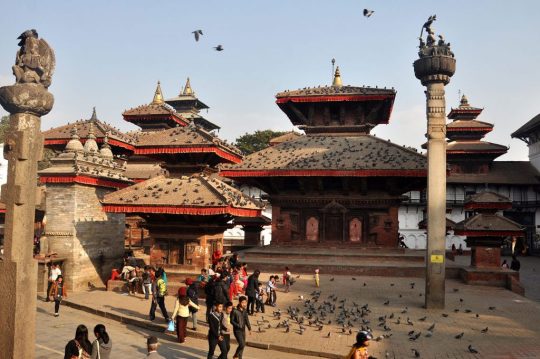







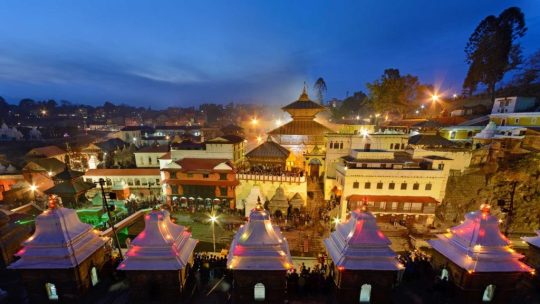
Read the full article
#whytogoNepal#ChhauniMuseum#NaryanhitiPalace#DurbarsquareKathmandu#TaudahaLake#KathmanduNepal#TravelNepal
0 notes
Text
What if The Mummy 3 had been a good film?
I recently rewatched The Mummy 3 and remembered all the things that were bad about it, but what annoys me is that they had a lot of the pieces for a good movie. In my annoyance, I have ended up thinking about how it could have gone. So here is my version of The Mummy 3, if it had been good.
Most of the backstory can stay the same but let's skip the Great Wall stuff because that doesn’t work geographically. Evil emperor, big army, wants to become immortal. He conquers loads of lands and then starts building a special site near Xian to research immortality. Loads of workers die but the emperor doesn't care and they end up buried in the foundations. As part of the research, the emperor hears about a mystic gem that's supposed to lead to the Fountain of Eternal Life, but he can't figure out how to make it work. He hears about a witch and sends his general out to find her. The rest is basically the same - love affair, murder, curse. The emperor and his armies are turned into terracotta. The emperor is sealed in his secret chamber but the rest of the soldiers are lined up outside it. The local people don't want the soldiers waking up, so they smash the warriors to bits and bury them, but they don't find the secret room with all the magic stuff.
Centuries later, a local farmer finds bits of broken warrior and Chinese archaeologists investigate (because why not give the Chinese credit for their own discoveries?) but they don't find the secret room. They think they've found the first emperor’s tomb and start reassembling the broken warriors, not knowing the danger they're in.
Backstory over, enter Alex, who's joined the dig and thinks he's found some information that will lead to the secret room. He finds it, there are some traps, and he finds the gem, the oracle bones, and what he thinks is a statue of the emperor. Lin comes in to try and kill him because she's afraid he'd going to raise the emperor. There's a fight, but he makes it out with the bones and the gem, while the Chinese military, led by General Yang, drive Lin out, saving Alex's life. The film is set in 1946, which is when the Chinese Civil War restarted (funny that the film never mentioned this) leading to the rise of communism, so you could have Yang talking about the unrest and thinking that Lin must be part of the rebellion. The army start to take the statues to Xian but Alex keeps the bones and gem with him.
Meanwhile, back in England, Rick attempts to learn to fish and fails spectacularly. He returns home and gets a phone call from New York. It's Evie. She's off putting together an exhibit (if they couldn't get the same actress, it would be better to not have Evie in the film at all) but Rick stayed behind because he got injured on their last dig and he's supposed to be resting and relaxing so he can recover. Instead of lying to each other and pretending to be happy when they're clearly not (because that retirement plotline made no sense for either character), Rick admits that he's finding this whole relaxation thing a challenge. He tells her what happened with the fish.
"Evie, it's not that funny. Stop laughing. Evie, I swear to god, stop laughing at me or I will end this call. Evie!"
Rick speculates about going over to join Evie because his injury is healed now, but she's nearly finished her work there and then Rick gets a letter from Alex, the son he loves and is really proud of and has a great relationship with (because all the family "drama" during the first half of the film was entirely unnecessary). Rick decides to go and join Alex instead, and that Evie can come to them when she finishes up in New York.
Jump to Jonathan's night club in Xian. Alex comes in, has a little exchange with Jonathan, bumps into someone spilling his drink and it looks like he's about to start a fight - only it turns out to be Izzy from the second film (because how many daredevil pilots is Rick friends with?). They have a drink and a chat. Alex asks what Izzy's up to these days and Izzy says he's still flying, mostly taking crazy tourists up through the mountains, but how even the most dangerous of flights is nothing like as dangerous as what he used to have to deal with when he was with the O'Connells.
"I swear, every time your dad shows up, someone tries to kill me."
*Rick appears.* "Hi, Izzy." *Three seconds later, Lin shows up and tries to steal back the gem and bones from Alex, leading to a big fight.*
Izzy: "Every time, O'Connell! Every time!"
Rick: "At least no one's shooting at you."
They all head to the statue to try and figure out what's going on. Alex deciphers some text and works out that the bones could be used to wake the emperor.
Rick: "Let's not do that."
Alex: "Yeah, Mum will be mad if we summon an ancient evil with magical powers while she's not here."
Rick: "And, you know, the whole 'ancient evil with magical powers' thing."
Alex: "Right. Yes."
But then Yang arrives because he was just waiting for Alex to decipher the ritual. There's a hostage situation, he forces Alex to do the spell to save his dad. Lin shows up to try and stop it but she's too late and the emperor's statue comes to life. All the other, broken statues in the area come to life too and start reassembling themselves. Insert humorous moment where two half-reconstructed statues get into a scuffle about which of them an arm belongs to. Lin stops trying to kill the O'Connells and they all start working together to try and take down the emperor.
Cue chase scene through the city, including a chase on the city walls (which are huge and awesome). Jonathan gets caught up in the chase scene.
Jonathan: "I hate mummies!"
Alex: "They're not actually mummies. They're soldiers who were cursed to become terracotta and now..."
Jonathan: "They're trying to kill us! Do you think I care about semantics?!" *Panic. Flail. Scream.*
This then becomes a running joke. Jonathan, Izzy, Rick, or someone else will refer to the emperor or his warriors as mummies, Alex will try to correct them, whoever it is will tell him it's not the time or they don't care.
The emperor and Yang get the gem and head off to find the fountain. The heroes set off after them with Izzy ("I'd better get another huge diamond out of this, O'Connell.") and Lin. Rick wonders if Ardeth Bay would have any ideas how to fight these mummies ("They're not actually..." "Not now, Alex."). No romance arc. No stupid yak jokes. Just a flight, a dodgy landing, a fight at the monastery, some yetis, the emperor puts the gem on the tower and sees the way, leaves everyone else buried in the avalanche.
Instead of Rick getting shot for family angst, having Izzy getting shot leading to mild angst and then later jokes.
Izzy, bleeding to death: "I should have known this would happen if I signed up with you again." *passes out*
Rick is guilty and grieving because he dragged Izzy into this. Lin leads the heroes into Shangri La to the fountain and they save Izzy. Played for jokes for the rest of the film ("I got shot" "You got better").
The emperor gets to the fountain, steals the oracle bones from them, gets his magical transformation powers, becomes a dragon that looks more like Chinese renderings of dragons instead of European pictures of dragons. He grabs Lin and flies off with her. Izzy flies the rest of them down and then goes off with Jonathan to fetch reinforcements.
Alex goes to rescue Lin, but she's halfway through her own escape attempt (because, seriously, why was she just sitting around waiting to be rescued in the film?). She's stolen back the oracle bones and needs to get them to her mum to raise all the dead people who were worked to death by the emperor. Lin's plan works. The emperor resurrects his army, but Lin's mum raises hers and there's a big fight. Lots of shooting. Stuff blows up. It looks like all hope is lost... and then Jonathan and Izzy show up with the promised reinforcements. They've brought Ardeth Bay and a bunch of his people and they fight the terracotta warriors.
Ardeth Bay: "I thought you said you were fighting mummies. These aren't mummies."
Alex: "Thank you! Finally!""
The emperor dies, the old general and the immortal witch are reunited, Izzy and Jonathan argue about which of them deserves to keep the giant diamond, Ardeth Bay and Lin bond over having to keep ancient evil people safe from these irresponsible English people who go around bringing them back to life, and Alex and Rick argue about which of them has to explain to Evie that they nearly destroyed the world again.
We skip cliched and painful romance arcs, we skip bad characterisation and unnecessary family drama, we don’t have the wrong actress playing a character without any of the chemistry of the original films, and the constant referring to creatures that aren’t mummies as mummies becomes a deliberate joke and not a plot hole.
#The Mummy 3#I spent way too long thinking about this#reworked plot#someone give me a time machine so I can fix this film
37 notes
·
View notes
Text
Klaros: An Oracular Center of Apollo in Western Anatolia
by Gülşah Günata, ANAMED Post-Doctoral Fellow (2018–2019)
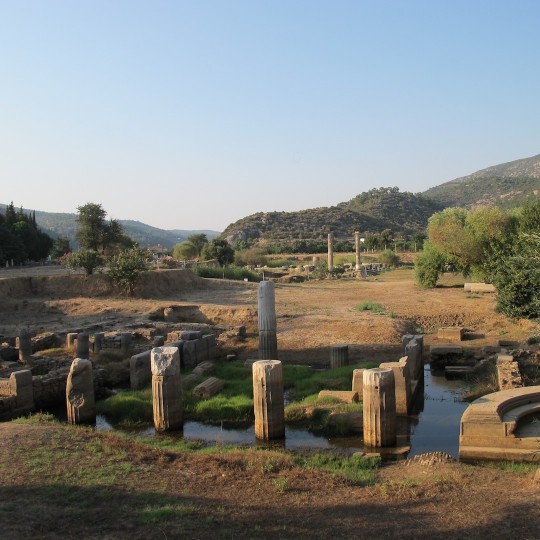
In this blog entry I want to take you away from Istanbul to a beautiful western Anatolian archaeological site near Izmir: Klaros, where I have been working every summer since 2006.

Views from Klaros (photos: Klaros excavation archive)
The sanctuary of Apollo at Klaros is one of the most important oracular centers of the ancient Greek world, where people came to learn about the future and the will of the gods. The site is located within the Ahmetbeyli quarter of the Menderes district, Izmir province, to the south of Cumaovası, in the lower part of the Ahmetbeyli (ancient Ales) Valley, which connects the plain to the Bay of Kuşadası on the south.
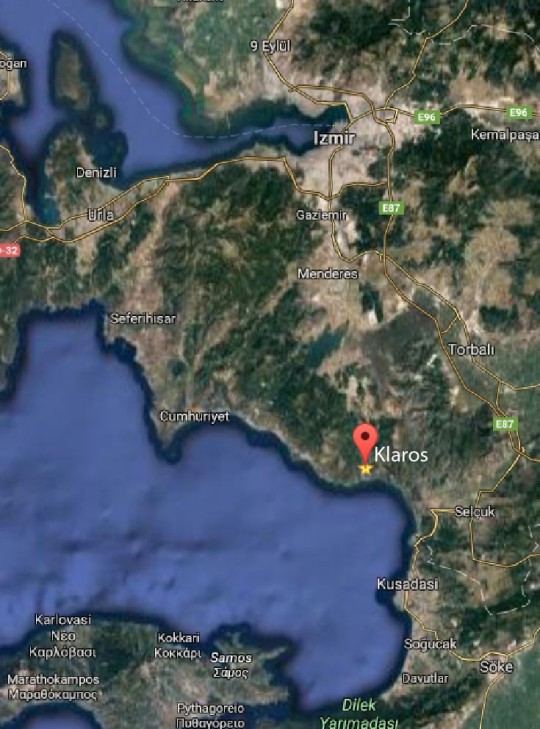
Map: Kuşadası Bay, Klaros (googlemaps)
The sanctuary is now located 1.6 km inside the coast line. However, a recent geological study and a coring program in the area have shown that the prior coast line was well inside of today’s coast and formed a long bay at the end of the third millennium BC. The bay began to be filled with alluvium in the second millennium BC, and the sanctuary of Klaros was founded over a marshy area. Klaros had a harbor during its early period. Thukydides describes anchored vessels near Klaros in his account of the Peloponnesian War between the Athenians and Spartans (3.33). The coastline grew further away from Klaros over time due to the silting action of the Ahmetbeyli (Ales, Halysus) River, and its tributary streams, the Kırmızıkayalar and Beynamaz. Klaros stayed buried under thick alluvial deposits for centuries, waiting to be discovered.
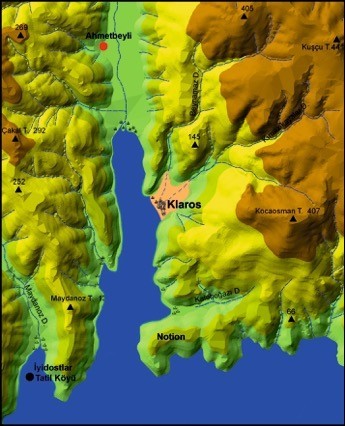
3rd Millennium BC (after Doğan 2008)
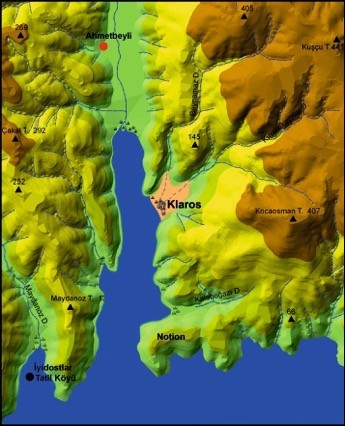
1st Millennium BC (after Doğan 2008)
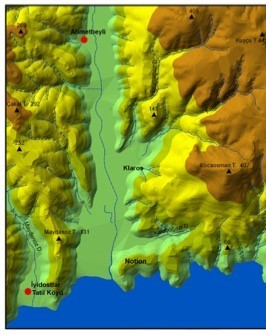
Present Day (after Doğan 2008)
Many travelers, starting with Richard Chandler in 1764, visited this area with the hope of finding the famous oracular center of Apollo. Francis V. J. Arundell in 1826, Charles Texier between 1833 and 1844, Carl Schuchhardt in 1886, and Theodor Macridy in 1904 tried to locate the sanctuary during their trips in Anatolia. Finally, T. Macridy was the one who discovered two columns and the inscribed ante walls of the ‘Propylon’, though he misinterpreted these architectural remains to be part of the temple of Apollo Klarios. Following this discovery, the first systematic investigation at Klaros started in 1913 by T. Macridy and Charles Picard. They revealed the entire ‘Propylon’ during this first excavation season and understood that this structure was not the temple of Apollo, but the entrance building of the sanctuary. They also uncovered the large ‘exedra’ on the east side of the ‘Propylon’ and numbers of inscriptions that were carrying the names of the delegates who came to the sanctuary for consultation mainly in the Late Hellenistic and Imperial period. Their research had to be ceased due to the start of the First World War in 1914. The second period of excavations in the sanctuary took place between 1950 and 1961, led by French epigrapher Louis Robert and his wife Jeanne Robert. Following them, another French scholar, Juliette de La Genière, led the work at Klaros from 1988 to 1997. The last excavation project in the sanctuary was started in 2001 by Nuran Şahin and is still continuing (see Şahin 2012 for detailed information on the research history at Klaros).
After giving a general brief information about the location, geography, and research history of the sanctuary I would like to take you further back to the mythical stories related to the foundation of Klaros.
Although we need to be cautious about accepting the truth of foundation legends, it is still important to consider what ancient authors claimed about the origins of the oracle and also the nearby cities. Pausanias says that “The people of Kolophon suppose that the sanctuary at Klaros, and the oracle, were founded in the remotest antiquity” (7.3.1). According to ancient texts, the establishment of the prophecy center of Apollo Klarios dates back to the 13th century BC (Paus. 7.3.1–2, 9.33.1; Apoll. Rhod. 1.308), which was the period of Achaean colonization of the Kolophonian land. Literary sources inform us that this region witnessed two overseas migrations consecutively in the Bronze Age. Pausanias points out that the locals of the region were Karians and the first migrants to the area had a Cretan origin (7.3.1): “They assert that while the Karians still held the land, the first Greeks to arrive were Cretans under Rhakios, who was followed by a great crowd also; these occupied the shore and were strong in ships, but the greater part of the country continued in the possession of the Karians.”
The second wave of migration to the Kolophonian land supposedly came from Greece (Sakellariou 1958, 345–346; Parke 1985, 119; Şahin 2007, 344). Pausanias informs us that the new arrivals were from the Theban community who had to leave their homeland after the Epigones conquered Thebes (Paus. 7.3.1–2). The captured Thebans were offered to Delphi as slaves. If we accept the accuracy of this story, the Mycenaean pottery found in the destruction level of the palace of Kadmos at Thebes might indicate that this incident took place around 1400–1300 BC (Sakellariou 1958, 347). The prophet of Apollo, Teiresias, and his daughter Manto were said to be among the slaves. Apollo ordered the Thebans to found a colony and Manto to establish a prophecy center in his name specifically in the Kolophonian land. Pausanias states that when Manto and the Theban immigrants arrived at Kolophon, Rhakios was still at war with the locals (Paus. 9.33.1–2). In his narration, Rhakios let the new arrivals settle down and married Manto. She then founded the prophecy center at Klaros following the order of the Delphic Apollo. According to some ancient authors, such as Apollonius of Rhodes, the sacred spring of Klaros was formed by the tears of Manto, who had been expatriated from her country (Apoll. Rhod. 1.308). Nikandros of Kolophon asserts that the name of the sanctuary comes from the Greek ‘kleros’ (κλῆρος), which means “share,” and says that Zeus, Poseidon, and Hades shared the universe here. Although the etymology of the prophecy center is disputable, it is the common opinion of ancient writers that its founder was Manto, and the date of the establishment occurred sometime before the Trojan War. Mopsos, the son of Manto and Rhakios, took over the kingship from his father and the task of prophecy from his mother. He was the first priest of Apollo and the king of Kolophonian land who drove the locals inland (Paus. 7.3.1).
After a long period of time, the land of Kolophon may have experienced another migration movement—the Ionian migration—according to the ancient authors. The seventh century BC elegiac poet Mimnermos describes the Pylians’ violent arrival on the Kolophonian coast (Mim. Frag. 9; Strabo 14.1.4): “We left the craggy city of Neleian Pylos, and came on ship to handsome Asia and lovely Kolophon our base. There we brashly mustered our immense army in dreadful pride, and set out along the river flowing inside the forest.” Even though the sanctuary at Klaros has revealed no evidence for the supposed Ionian migration to the land of Kolophon and no information has been found regarding the impact of any migration movements to the prophecy center yet, the recent excavations revealed evidence for the foundation of the sanctuary as early as the 13th century BC. However, due to the physical conditions of the sanctuary it has not been possible to reach the probable Minoan (the first immigrants according to the legends) levels at Klaros. The underground springs and the high level of basement water had been an overwhelming problem for the ancient residents of the sanctuary, and it still causes difficulties for the excavations. We can only say that we have evidence for activity in the sanctuary as early as the 13th century BC.
The earliest architectural remains of cult activity in the sanctuary is the circular altar of Apollo. Material, mainly ceramics, from the circular altar indicates activity during the Late Bronze/Early Iron Age transition period. Numerous animal bones with burnt marks, terracotta bull figurines in various sizes, and ash deposits were found in the area of the circular altar together with Protogeometric and Geometric pottery sherds and material artifacts.
The Archaic period at Klaros shows a change in cult activities with an increase in votive offerings and the emergence of the first temples of Apollo, Artemis, and Leto. Beside the temples a larger rectangular altar for Apollo was built over the earlier circular one, and two smaller altars were erected for Artemis and Leto to the north and the south respectively. This is the period of new trend in building monumental structures in sanctuaries in the Greek world, and Klaros was no different.
The Classical period of the sanctuary reflects the political situation and events in the Greek world. The Persian attacks had an effect on religious places as in all other aspects of life in western Anatolia and the Greek mainland (see Miller 1999). The Archaic structures continued being used for religious rituals in this period and no construction of a new structure seems to have taken place in the sanctuary, except some necessary architectural renovations. The architectural evidence suggests an interruption or recession in the cult, and the decrease in the amount of Classical material supports the argument of a hiatus at Klaros in the fifth century BC due to the Persian attacks.
Following Alexander the Great’s defeat of the Persians, Klaros became famous in the Greek world as an oracular center. Pausanias narrates Alexander’s dream about moving Smyrna to a new spot and sending ambassadors to consult Apollo at Klaros (7.5.1–2): “It is said that Alexander was hunting on Mount Pagos, and that after the hunt was over he came to a sanctuary of the Nemeses, and found there a spring, and a plane-tree in front of the sanctuary, growing over the water. While he slept under the plane-tree, it is said that the Nemeses appeared and bade him found a city there, and to remove into it the Smyrnaeans from the old city. So, the Smyrnaeans sent ambassadors to Klaros to make inquiries about the circumstance, and the god made answer: Thrice, yes for times blest will those men be who shall dwell in Pagos beyond the sacred Meles.”
After the death of Alexander the Great, the sanctuary underwent two extensive construction projects during the rules of Antigonos Monophthalmos (“the one eyed”) in 311–306 BC, and Attalos I in the third century BC, which continued until the end of the life of the sanctuary in the fourth century AD. The construction of the Hellenistic temples of Apollo and Artemis, the altars, the ‘exedrai’, the ‘propoylon’, the honorific monuments, and the hecatomb, which all can be seen at the site today, was started during this period. The Apollo temple was never completed, probably because of its largeness. The cult statues of the Triad—Apollo, Artemis, and Leto—were also erected in the Hellenistic period and are still standing today.

Cult statue group: Artemis, Apollo, and Leto (photo: Klaros excavation archive)
Bibliography
Apollonius Rhodius. ‘Argonautica. LCL’ 1 (edited and translated by W. H. Race), Cambridge, MA: Harvard University Press. 2009.
Mimnermus. ‘Fragments. LCL’ 258. ‘Greek Elegiac Poetry: Tyrtaeus, Solon, Theognis, Mimnermus’, (edited and translated by D. E. Gerber). Cambridge, MA: Harvard University Press. 1999.
Pausanias. ‘Description of Greece I-V: Books 1-10. LCL’ 93, 188, 272, 297–298 (5 volumes), (translated by W. H. S. Jones). Cambridge, MA: Harvard University Press. 2006.
Strabo. ‘The Geography: Books 1–17. LCL’ 49-50, 182, 196, 211, 223, 241, 267 (8 volumes), (translated by H. L. Jones). Cambridge, MA: Harvard University Press. 2005.
Thukydides. ‘History of the Peloponnesian War: LCL’ 9 (translated by C. F. Smith), Cambridge, MA: Harvard University Press. 2005.
Parke, H.W. 1985. ‘The Oracles of Apollo in Asia Minor’. London.
Sakellariou, M.B. 1958. ‘La Migration Grecque en Ionie’. Athens.
Şahin, N. 2007. “Notion-Klaros-Kolophon Üçgeninde Myken Sorunu.” In ‘Patronvs. 65. Yaşında Coşkun Özgünel’e Armağan’, edited by E. Öztepe, M. Kadıoğlu. İstanbul. 329–338.
Şahin, N. “Apollon Klarios Bilicilik Merkezi” In ‘Ege Üniversitesi Arkeoloji Kazıları’, edited by A. Çilingiroğlu, Z. Mercangöz, G. Polat. İzmir. 247–72.
1 note
·
View note
Note
I'm so thankful that you always post and talk about dramas you're the one who got me into dramas finding your blog . Is the reincarnation lovers trope a favorite of yours? I was just wondering if you had a list of dramas that had it where they're always only for each other if you don't mind. :)
Awwwwww, thank you!!!!
It’s a trope I enjoy when done well but it’s not a favorite trope per se.
Here is the list of cdramas which I enjoyed with it. At least one person in these reincarnates :)
Ancient Terracotta War Situation
Dreaming Back to the Qing Dynasty
Eternal Love of Dream
Granting You a Dreamlike Life
Love and Redemption
Three Lives Three Worlds Ten Miles of Peach Blossoms
I am not sure The Untamed and The Legends would qualify since those people have all the memories but just in case.
There is also Tale of the Nine Tailed in kdramas, Telugu movie Magadheera and Bollywood oldie Hameshaa that I’ve enjoyed.
8 notes
·
View notes
Link
When the FBI showed up at Don Miller's home in rural Indiana in 2014 to seize part of his vast personal collection of artifacts, it was a shock for people who knew him.
"He was very beloved. He was very charismatic," former local reporter Liz Dykes said. Dykes interviewed the 90-year-old former engineer about his time in World War II, his missionary work in Haiti, and most of all, his huge collection of artifacts from around the world.
"The entire house is a museum. There are things everywhere," Dykes recounted. "It was just mind-blowing."
Miller willingly showed his collection to reporters, residents, and even local Boy Scout troops, so when the FBI came calling, she said, "I wanted to know what they were looking for... There had to have been something."
There was: something the FBI hasn't talked about—until now.
"When I first went into his house and saw the size of the collection, it was unlike anything we'd ever seen," Tim Carpenter, who heads the FBI's art crime unit, told CBS News correspondent Anna Werner. "Not only me, but I don't think anybody on the art crime team."
FBI photos – never before shown publicly – give a glimpse of the collection: some 42,000 items, including pre-Colombian pottery, an Italian mosaic, and items from China, some that Miller labeled "Chinese Jewelry" from 500 BC.
"Roughly half of the collection was Native American, and the other half of the collection was from every corner of the globe," Carpenter said.
But the problem? Carpenter said a lot of it had been illegally obtained. Miller admitted he'd gone on digging expeditions in foreign countries and around the United States for decades in violation of antiquities laws.
"Did he understand that he had obtained some things illegally?" Werner asked.
"He did," Carpenter said, adding that Miller admitted to it.
Miller eventually agreed to let the FBI seize some 5,000 artifacts so they could be returned to their countries of origin. But Carpenter said all the FBI's careful planning couldn't prepare them for another, more disturbing discovery.
"About 2,000 human bones," Carpenter said. "To the best of our knowledge right now, those 2,000 bones represent about 500 human beings."
Nearly all of those human remains, he said, were also dug up from ancient Native American burial sites.
"It's very staggering," Carpenter said.
"Why would anybody have that many human bones?" Werner asked.
"I don't know. I truly don't know," Carpenter said.
Native American burial sites dating back thousands of years have been a source of fascination for archeologists for decades. One old government film showed the excavation of an ancient Native American village in Alabama. Over time, many other sites have been looted by people seeking artifacts and even skeletons.
"This comes down to a basic human right," said Holly Cusack-McVeigh, a professor of archaeology brought in by the FBI on the Miller case.
"We have to think about the context of: Who has been the target of grave robbing for centuries? Whose ancestors have been collected for hobby?" Cusack-McVeigh said. "And this comes down to racism. They aren't digging white graves."
Experts determined the remains found at Miller's residence likely came from Native American tribes including the Arikara. In North Dakota, tribal official Pete Coffey is working with the FBI to bring them home.
"All too often here we have been treated as curiosities rather than a people here," Coffey said. "They could very well be my own great, great, great, great grandfather, or grandmother, you know, that had been – I characterize it as being ripped out of the earth, you know."
Miller died in 2015. We wanted to know what his widow thought about all this, so we went to Miller's home, where a Chinese terracotta warrior figure stood guard outside.
"I can't comment on the situation at this time," Miller's wife said.
But Carpenter believes in his later years, Miller understood the ramifications of what he did.
"I think he felt compelled to try and do the right thing and return these home," Carpenter said.
Returning those Native American ancestors home is what Carpenter calls the FBI's most important mission now.
"You have to treat these people with dignity. These are human beings and people. It matters. It has meaning to people today, it has meaning to our children and their children," Carpenter said.
So far, the FBI has already returned items from Miller's collection to several countries, including Cambodia, Canada, Colombia, and Mexico. A Chinese delegation will go to Indianapolis this week to claim artifacts. They have already returned some Native American ancestral remains to tribes in the South Dakota region and are planning a large-scale repatriation of remains to other tribes in the coming months.
0 notes
Link
Situated between Milan and Venice, the cosmopolitan city of Vicenza can sometimes be overlooked in favor of its more popular neighbors.
A center for art in the Veneto region of northeastern Italy, Vicenza is rife with elegant piazzas, villas, churches, museums, and art galleries. The Palladian Villas, established as a UNESCO World Heritage Site in 1994, are arguably the city’s most famous inhabitants. Aside from its evident cultural importance, Vicenza is also Italy’s third largest industrial center making it one of the country’s wealthiest cities. It has established textile, steel, and computer engineering industries with the microprocessor’s co-founder Federico Faggin coming from Vicenza.
The city used to be called Vicetia or Vincentia, a name given by the Romans which means victorious. Before eventually becoming part of the Kingdom of Italy in 1866, the city came under the rule of Venice, Napoleon, and the Austrian Empire. Vicenza’s area became a major combat site during World War One, and after the second World War the city was the most heavily damaged by Allied bombings in the Veneto region. Staying true to its name, Vicenza rose victorious and rebuilt itself from the rubble. As of 2014, the city has a population of around 113,627.
Italy has a rich culture that is not limited to Rome, Venice, and Milan. This gem of a city is one to visit if you want to delve deeper into Italy’s aristocratic culture outside the major cities. Teeming with elegance and sophistication, the city of Vicenza is truly victorious in more ways than one.
1. Watch performances at the Teatro Olimpico
Built in 1589 to imitate Roman amphitheaters, this elliptical theater still holds some musical and theatrical performances despite its age. Teatro Olimpico was designed by renowned architect Andrea Palladio, who died before its completion. Established as a UNESCO World Heritage Site in 1994, it is one of the only remaining Renaissance theaters in the world.
To avoid damage, the theater can only accommodate around 400 people. It also becomes the venue for the Vicenza Jazz Festival in spring and the Season of Classical Performances in autumn.
2. Visit the amazing Villa Capra
Also known as La Rotonda, this magnificent villa has been visited by artists, poets, statesmen, and many other wonder-seeking travelers. Designed by the city’s famous architect Andrea Palladio, the villa obtained the name Capra after the Capra brothers who completed it in 1592. It was originally commissioned by Paolo Almerico, a Vicenzan priest who retired from the Vatican. Part of the Palladian Villas which obtained UNESCO World Heritage Site status, Villa Capra houses elaborate trompe l'œil frescoes and has even inspired the design of many buildings including the home of former American president Thomas Jefferson.
There is a bus from the city’s train station that takes visitors to Villa Capra. Visitors can also choose from a tour of both the interior and garden or just the exterior of the villa.
3. View exhibitions at the Basilica Palladiana
Another one of Andrea Palladio’s masterpieces is this 15th-century palazzo which once housed law courts and the Council of Four Hundred. One of its most striking features is a copper dome which looks like the hull of an upturned ship. Its porticoes and loggias underwent constant reconstruction until its completion in 1614.
The basilica contains three rooms reserved for exhibitions. It is also the location of the Museo del Gioiello, which contains a collection of historic jewelry.
4. View art at the Palazzo Leoni Montanari
This palace from the late Baroque period is a must-see for art enthusiasts. Aside from a vast collection of ancient pottery, it also contains a collection of 400 Russian icons, numerous paintings, and even elaborate depictions carved into marble.
5. Learn about the city's architectural history at the Palladio Museum
Dedicated to the life and work of Andrea Palladio, this modern museum showcases all that you need to know about the brilliant Vicenzan architect. It contains various historical artifacts including Palladio’s 16th-century Quattro Libri dell'Architettura (Four Books of Architecture). Decked in frescoes, the museum also has architectural models of Palladio’s famed palazzi and villas.
6. Stroll around Corso Andrea Palladio
Lined with many Renaissance-era palaces and mansions, walking through Vicenza’s main street feels like a dream. Aside from architectural masterpieces, visitors will pass by a variety of restaurants and shops perfect for a gastro-tour of the historic city.
7. Admire history at the Chiesa di Santa Corona
This Gothic church built in 1251 houses a variety of paintings and frescoes dating back to the early 15th-century. Truly a historic as well as architectural marvel, it unsurprisingly has something to do with Vicenza’s famous architect. The church, aside from containing the Palladio-designed Valmarana chapel from 1576, is also the final resting place of Andrea Palladio.
Although the church is open for tours, visits are suspended during religious services. The tours provide visitors with a free digital guide accessible via smartphones and tablets.
8. Visit the Palazzo Chiericati
It shouldn’t be surprising that Vicenza has a wealth of palaces that contain vital pieces of history. This Renaissance-era palace, designed by Andrea Palladio in 1550, was only completed at the end of the 17th-century. It was restored and opened as a museum during the 19th-century.
Visitors are treated to a plethora of paintings, frescoes, sculptures, and other pieces of art dating back to the 16th and 17th centuries.
9. Tour the romantic Villa Valmarana ai Nani
This stunning fairy tale-like villa is both a place you can visit and stay in. Built in 1669, the villa contains 17 stone sculptures of dwarves as well as frescoes depicting scenes from famous Greek and Italian literature. The palace is divided into three parts: the Palazzina (Owners’ Residence), the Foresteria (Guesthouse) and the Scuderia (Stables). There is also a cafe and footpath that leads to La Rotonda, Vicenza’s most famous villa. The gardens and formal reception rooms are open to the public, and sometimes weddings are also held in the estate.
10. Discover the hidden wonders of the Roman Criptoportico
Vicenza has a lot of wonders not limited to the world above. Discovered in 1954, this first century Roman criptoportico is known as the only private criptoportico in northern Italy that has been unearthed so far. It is located six meters (19.68 feet) below ground and contains a three-sided passageway, terracotta flooring, and a medieval well. It also has a heavy door which archaeologists believe once guarded valuable items.
Read also: Top 8 things to do in Toulon, France
From : https://wikitopx.com/hotels/top-10-things-to-do-in-vicenza-italy-707396.html
0 notes
Text
Explore Dong Thap, land of the lotus, for just $20
Marketing Advisor đã viết bài trên http://www.ticvietnam.vn/explore-dong-thap-land-of-the-lotus-for-just-20/
Explore Dong Thap, land of the lotus, for just $20


December to April is suitable for travelers who prefer the dry season.
The estimated cost of this two-day trip is VND500,000 – 700,000 per person ($21.34 – $29.87). The price varies depending on the quality of transportation, housing and the place you choose to visit.
Day 1
The best places to see in Sa Dec City, the southern province of Dong Thap are Tan Quy Dong flower village, Huynh Thuy Le ancient house, and Kien An Cung Pagoda. It takes only 2 – 3 hours to visit all of them.

Two farmers are working in a flower village in Sa Dec City. Photo by Shutterstock/Dory F
Tan Quy Dong flower village: As one of the most important flower-growing centers in southern Vietnam, this village has a history of more than 100 years in growing flowers. You will find more than 50 types of flowers with all sorts of colors and fragrances such as chrysanthemum morifolium, petunia, lisianthus, marigold, moss rose, iris, dahlia.

The front of Huynh Thuy Le ancient house in Sa Dec City. Photo by Shutterstock/Vivanvu
Huynh Thuy Le ancient house: Situated on a street along the Sa Dec River, this 100-year-old house combines both Western and Asian styles. Thanks to the success of the movie and novel “The Lover,” about the love story in 1929 between the Chinese house owner Huynh Thuy Le and French author Marguerite Duras, the house attracts thousands of tourists every day.
Kien An Cung Pagoda: Built in Chinese style, Kien An Cung was built by immigrants from Fujian in China to honor their ancestors and educate the next generation. Many tourists visit this pagoda to take photographs and learn about the culture.
Day 2

Cao Lanh Market gate. Photo acquired by VnExpress
Cao Lanh Market: Having been around more than two decades, this market is remarkable for its decoration with pink lotus, the symbol of the province. On two sides of the market are temples that honor its two owners, who are famous for their magical powers, especially among businesspeople.
Van Thanh Mieu: This is a temple that promotes learning and preserves Confucian teachings. Today the area surrouding Van Thanh Mieu is a large park called the Park of Van Mieu, a public space for outdoor activities for locals.
Dong Thap has three beautiful and large melaleuca forests. It takes half a day to explore each, so you should choose one of them since you are on a two-day trip.
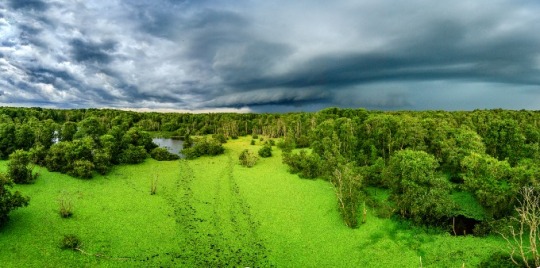
A paranomic view on Tram Chim village. Photo by Shutterstock/Tonkinphotography
Tram Chim National Park: Situated 40 km from Cao Lanh, the park has hundreds of species of animals and around 130 types of plants. You can go deep into the forest by canoe to see many rare endemic birds. Admission costs VND40,000 ($1.71) for an adult and a canoe costs around VND500,000 ($21.43).
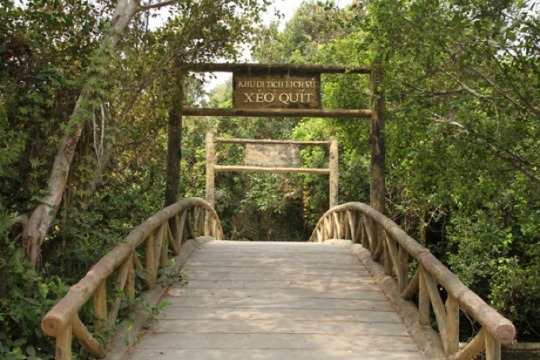
The entrance to Xeo Quyt. Photo by Shutterstock/HuPa
Xeo Quyt historical site: 30 km from Cao Lanh, this site is known to have the most beautiful path through/across the melaleuca forest of Vietnam. Walking or sitting in a rowboat snaking through the forest, you can see a revolutionary base during the Vietnam War (1955 – 1975). An admission ticket costs VND10,000 ($0.43).

Gao Giong Eco-Tourism Park in Dong Thap Province. Photo by Shutterstock/Vivanvu
Gao Giong Eco-Tourism Park: This melaleuca forest, 15 km from Cao Lanh, has tens of thousands of white storks and is one of the largest stork habitats in Dong Thap Muoi (Plain of Reeds). Gao Giong is also a source of seafood for Dong Thap Muoi’s signature foods. An admission ticket costs VND10,000 ($0.43).
Dong Thap Muoi is an inland wetland in Vietnam’s Mekong Delta. Most of the wetlands are within Long An Province and Dong Thap Province.
Transportation
Since Dong Thap is about 170 km from Ho Chi Minh City, you can go there by motorbike or car, which is the most convenient option for explorers. Buses are also available and cost VND90,000 – VND200,000 ($3.84 – $8.54) from Mien Tay bus station (Ho Chi Minh city) to Cao Lanh or Sa Dec, and the trip takes 3 – 4 hours.
Transportation is quite convenient in Dong Thap with a wide variety of options such as taxi, motorbike taxi (xe om), boat, and ferry. You can also rent a motorbike in Cao Lanh and Sa Dec city for VND100,000 – 200,000/day ($4.27 – $8.54).
Housing
Motel and hotel prices in Dong Thap are quite low, ranging from VND50,000 to 70,000 per night ($2.13 – $2.99). If you are a nature lover, you can try sleeping in wooden huts above lotus fields in Thap Muoi, a rural district of Dong Thap
If you want to discover the local culture, you can also try homestays in Sa Dec. But motels and hotels in Cao Lanh are the most convenient option.
Signature food
You should definitely try signature local dishes such as grilled mullet fish wrapped in lotus leaf, steamed rice wrapped in lotus leaf, Sa Dec rice noodles, Lai Vung fermented pork roll and mandarine, Vietnamese dragon blood rice, and lotus milk.
In addition, Tien Giang River and Hau Giang River offer signature dishes made from linh fish, sesbania sesban flowers, stock garden, stir-fried mouse, Cao Lanh grilled mouse in a terracotta jar, Sa Giang shrimp chips, pink lotus wine…
Restaurants can be easily found in local markets and night markets. Food prices are quite affordable. It is advisable to find eateries in densely populated areas.
window._io_config=window._io_config||;window._io_config["0.2.0"]=window._io_config["0.2.0"]||[];window._io_config["0.2.0"].push(page_url:"https://e.vnexpress.net/news/travel-life/explore-dong-thap-land-of-the-lotus-for-just-20-3844082.html",page_url_canonical:"https://e.vnexpress.net/news/travel-life/explore-dong-thap-land-of-the-lotus-for-just-20-3844082.html",page_title:"Explore Dong Thap, land of the lotus, for just $20",page_type:"article",page_language:"en",article_authors:[],article_categories:["Travel & Life"],article_subcategories:["Travel & Life"],article_type:"longread",article_word_count:"101",article_publication_date:"Sun, 25 Nov 18 09:11:17 +0000");(function(d,s,id)var js,fjs=d.getElementsByTagName(s)[0];if(d.getElementById(id))return;js=d.createElement(s);js.id=id;js.src="http://connect.facebook.net/vi_VN/sdk.js#xfbml=1&version=v2.0";fjs.parentNode.insertBefore(js,fjs);(document,'script','facebook-jssdk'));
0 notes
Text
Team finds world′s oldest intact shipwreck in Black Sea | News | DW
The British-ledteam, which has been scouring the sea floor off Bulgaria for the past three years, on Tuesday said it had found a 2,400-year-old Greek ship intact on the sea bed.
Carbon dating was used to confirm the vessel’s age, and that it was the oldest known intact shipwreck. The wreck was found at a depth of more than 2,000 meters (6,500 feet) where the water has no oxygen — meaning that organic material can be preserved for thousands of years.
youtube
The design used to construct the ship was previously only seen in pictures on Greek pottery.
Team leader John Adams, from the University of Southampton, said researchers could learn a lot from the find.
“A ship, surviving intact, from the Classical world, lying in over 2 kilometers of water, is something I would never have believed possible,” Adams said. “This will change our understanding of shipbuilding and seafaring in the ancient world.”
New search methods
The team, which includes British, Bulgarian, Greek, Swedish and US marine researchers, used geophysics, sediment core sampling and underwater exploration to study changes in sea level after the last ice age.
Read more: Australia’s first submarine found after vanishing in WWI
The project has taken three years and used technology — including specialist deep water camera systems — that was only previously available to oil companies. The researchers discovered some 60 shipwrecks in all, including a 17th century Cossack raiding fleet and Roman trading vessels loaded with amphorae — pot containers used to carry goods.
An early Bronze Age settlement was also found near to former shore of the sea.
Travel tips for fans of archaeology
A window into the past
Sometimes the earth reveals them voluntarily, sometimes they are found by chance and often they are searched for – archaeological riches. Excavation sites around the world offer fascinating insights into the origins of our cultures.
Travel tips for fans of archaeology
Terracotta Army, China
Farmers came across a clay figure while working near Xi’an in 1974. Their discovery was a sensation. They had stumbled upon the mausoleum of the first emperor of China: Qin Shihuangdi, who died in 210 BC. Since then, thousands of life-size terracotta soldiers have guarded the tomb of the ruler. With about 100 square kilometers, the imperial tomb is the largest excavation site in the world.
Travel tips for fans of archaeology
Angkor Wat, Cambodia
240 kilometers (149 miles) northwest of the capital Phnom Penh, in the middle of the jungle, lies the enchanted temple complex of Angkor Wat – part of a medieval city of millions, ornately built from sandstone. 150 years ago the French colonial rulers discovered the sunken empire of the Khmer, who once lived here. The stone reliefs on the temple walls tell their story.
Travel tips for fans of archaeology
Machu Picchu, Peru
The old Inca town of Machu Picchu was once only accessible on foot via a steep path. It is situated 2,360 meters (7743 ft.) up in the Andes. Not even the Spanish conquerors advanced to this point. The terraced city was only discovered about one hundred years ago. Built in the 15th century, it is regarded as an impressive example of the high culture of the Incas.
Travel tips for fans of archaeology
Uxmal, Mexico
3000 years ago the Maya founded settlements all over Central America. Especially on the Yucatán peninsula in Mexico. Uxmal is considered one of the best preserved Mayan sites. In the center of the city: the Pyramid of the Magician, 38 meters (125 ft.) high. This Mayan sanctuary took 300 years to build. As tempting as it is, you are not however allowed to climb up it.
Travel tips for fans of archaeology
Pompeii, Italy
The eruption of Vesuvius in the Gulf of Naples in 79 AD was devastating. The ash rain buried the city of Pompeii and its inhabitants. After their corpses had decomposed, cavities remained, which were later filled with plaster by conservationists. The plastic plaster casts of people in mortal fear leave no visitor to the excavation site untouched.
Travel tips for fans of archaeology
Troy, Turkey
German archaeologist Heinrich Schliemann was obsessed with Troy. At the end of the 19th century he began digging in the Turkish province of Çanakkale. His guide was the Iliad, the account of the Trojan War by the Greek philosopher Homer. Schliemann actually found a settlement. An important center of the Bronze Age, but whether it is actually Troy remains unclear to this day.
Travel tips for fans of archaeology
Delphi, Greece
When you hear Delphi, you immediately think of the oracle of Delphi. The city was founded in the 7th century B.C. and was the center of the world for the people of antiquity. A place of pilgrimage for kings and all who sought advice. It was given to them in the temple of Apollo, by the priestess Pythia – the oracle of Delphi.
Travel tips for fans of archaeology
Forum Romanum, Rome, Italy
Researchers suspect that almost 2000 ancient cities are located on the territory of the former Roman Empire. Every Roman settlement had a center with temples, administrative buildings, shops and public squares – the so-called Forum. The Forum Romanum was more than that, it was the center of the entire Roman Empire. It is still one of the most important excavation sites of ancient Rome.
Travel tips for fans of archaeology
Pyramids of Giza, Egypt
They are located near Cairo and are over 4,500 years old. Built as tombs for the Pharaohs Menkaure, Khafre (Chephren) and Khufu (Cheops) (from left to right), after whom they are also named. Although researchers have examined the inside of the pyramids with the most modern technology, the hidden chambers and galleries still keep their thousand-year-old secrets to this day.
Travel tips for fans of archaeology
Petra, Jordan
First you pass through a narrow gorge, then you can see monumental temples carved into the rock. Many caravan routes led through the capital of the Nabataeans, which had its heyday as a trading center from the 5th to the 3rd century BC. T.E. Lawrence aka Lawrence of Arabia raved about Petra as “the most wonderful place in the world”. To this day, the desert city enchants its visitors.
Travel tips for fans of archaeology
Cave of Lascaux, France
Deer, aurochs and horses – these are the best preserved prehistoric paintings in Europe, discovered in 1940 in a cave near Montignac. They are said to have originated 17,000 years BC. The cave is now closed for conservation reasons. However, visitors can admire the works of art by their ancestors in a perfect reproduction of the cave.
Travel tips for fans of archaeology
Stonehenge, England
The megaliths near Salisbury date from the Neolithic Age and are probably the most famous stone circle in the world. Their purpose remains a mystery: cult site, temple complex, observatory? Some stones are aligned with the summer solstice. At the equinox of the day and night, thousands of people still celebrate the sunrise in this mythical place.
Author: Anne Termèche
rc/msh (dpa, AFP, AP)
Each evening at 1830 UTC, DW’s editors send out a selection of the day’s hard news and quality feature journalism. You can sign up to receive it directly here.
document.addEventListener("DOMContentLoaded", function (event) { if (DWDE.dsgvo.isStoringCookiesOkay()) { facebookTracking(); } }); function facebookTracking() { !function (f, b, e, v, n, t, s) { if (f.fbq) return; n = f.fbq = function () { n.callMethod ? n.callMethod.apply(n, arguments) : n.queue.push(arguments) }; if (!f._fbq) f._fbq = n; n.push = n; n.loaded = !0; n.version = '2.0'; n.queue = []; t = b.createElement(e); t.async = !0; t.src = v; s = b.getElementsByTagName(e)[0]; s.parentNode.insertBefore(t, s) }(window, document, 'script', 'https://connect.facebook.net/en_US/fbevents.js'); fbq('init', '157204581336210'); fbq('track', 'ViewContent'); }
Source link
The post Team finds world′s oldest intact shipwreck in Black Sea | News | DW appeared first on Today News Stories.
from WordPress https://ift.tt/2O1kdlU
via IFTTT
0 notes
Link
Experience the sights, culture, history and entertainment of the ancient city.
From colourful festivals to its world-renowned art and artifacts, here are the top things to see and do when in Benin City.
The capital city of Edo state, Benin City, has a long history of civilization and culture. The entire state of Edo was the location of one of Africa's oldest Empire's, the Benin Imperial Kingdom. Places to explore are fantastic, not far apart and not so expensive.
This article highlights the sights and sounds of the ancient majestic empire.
1. The Oba's Palace
The Royal Palace of the Oba of Benin is the most prestigious site in Benin and one of the most famous Royal Houses in the whole of Africa. The palace, built by Oba Ewedo (1255AD – 1280AD), is situated at the heart of ancient City of Benin. It was rebuilt by Oba Eweka II (1914 – 1932) after the 1897 war during which it was destroyed by the British. The palace was declared a UNESCO Listed Heritage Site in 1999. It is seen as a sacred site so it has its dos and don'ts — including no wearing of black, no whistling, no pointing at the Oba or his chiefs, etc.
2. The Benin Moat
The Benin Moat is an iconic monument in Nigeria. It is the largest man-made earthworks in the world that encircles the old perimeter precincts of the City. It was constructed as a defensive barrier in times of war. One of the wonders of the world, it predates the use of modern earth-moving equipment or technology in these parts.
3. Benin City National Museum
The Benin City National Museum was relocated to the public in 1973, as it was formerly in the Oba's Palace. It is home to a large number of Nigeria’s terracotta, bronze, and cast iron artefacts. The Museum contains priceless objects of antiquities from Benin Kingdom and other parts of the country. With 3 galleries, the museum is one of the largest museums in terms of indigenous artefacts in Nigeria.
4. Okomu National Park
Okomu National Park is the smallest of the forest reserves in Nigeria with a forest that covers only 1,082 sq km. It holds a small fragment of the rich forest that once covered the region, and is the last habitat for many endangered species. One can find buffaloes, red river hogs, chimpanzees, leopards, bush baby, putty nosed guenon, porcupine, pangolins, duikers, and antelopes at the park. It is also a sanctuary for the white-throated monkey, one of the rarest in the world.
5. Igun Street
Igun-Eronmwon quarters is one of Benin City’s most visited tourist attractions as the home of the brass/bronze casting industries in Benin. It is also listed as one of the UNESCO Cultural Heritage sites. Tourists stop by to buy artifacts and trinkets.
6. Igue Festival
Igue festival is celebrated between Christmas and New Year. It includes the Oba's blessing of the land and his people. The festival originated as a celebration to renew Oba Ewuare's magical powers. During the Igue ritual season, the Oba is prohibited from being in the presence of any non-native person.
7. Egedege N'Okaro
The Egedege N'Okaro is regarded as the first storey-building in Benin Kingdom, built in 1906, by High Chief Osawe Iyamu, the then Inne of Benin. This also makes it the second oldest story-building in Nigeria after the first one at Badagry, Lagos built in 1845 by white missionaries. Egedege N' Okaro is situated at House No 30, Erie Street,off Sakponba Road,in ancient city of Benin.
8. Kada Plaza
Kada plaza is a contemporary hub in Benin City. It is one of the best places to hang out, relax or just have a fun time. There's a cinema, Chinese restaurant , shopping complex and go kart racing available, for anyone who wants to take a breather from all the history in the town.
9. Somorika Hills
Somorika hills consists of a hiking trail and a shrine. Located in Akoko, Edo located about 5 km northeast of Igarra, the natural rocky ascents go as high as 518 meters. The town itself boasts of seven hills, each with its own unique features and names. Ogundugundu is the highest and longest of them all, while one of the geographical wonders is the Oriakpe Hill, where the rock wears a little cap shaped like a fingernail. People from all over the world come to Somarika to be healed as it is known for its spiritual and physical healing powers.
via NigeriaNews | Latest Nigerian News,Ghana News,News,pulse, and Latest News In Ghana In a Splash
0 notes